Chapter Five:A Comprehensive Data Analysis Indicates the Number of Liver and Kidney Transplants Performed by Chinese Hospitals is Significantly Larger than Previously Understood
Summary: Our calculation indicates that among the 865 hospitals suspected of organ harvesting, the 712 hospitals that engage in liver and kidney transplants had performed altogether as many as 400,000 cases of liver and kidney transplants by the end of December 2014. The single greatest difference between this report and other previously released investigative reports on organ harvesting is the fact that we have utilized the method of big data analysis. Our analysis examined every hospital one by one, determined the number of transplants conducted by each hospital, and then added up these numbers.
In order to arrive at these results, we researched and compared hundreds of thousands of articles, reports, and published medical papers related to these hospitals, searching and culling for information pertinent to our purpose. Through rigorous multiple-logic analysis, cross-examination and mass information analysis, this report ensures that every piece of data in the report has detailed and reliable source(s) and can be verified in at least two ways. To ensure that the final conclusions we have arrived at can withstand scrutiny, the data inferred in the report is strictly based on facts and evidence acquired in the course of our investigation.
We have taken the most conservative approach in determining every piece of numerical data. Here are two examples: (1) if a certain hospital claims it has conducted kidney transplant but does not provide any specific number, we assume this hospital has performed only one case of kidney transplant; (2) with regard to the 169 hospitals designated by the Ministry of Health to perform organ transplants that have not released the actual numbers of transplants performed, we used only the minimum number required of a hospital to be qualified for such designation. This ensures that any party that attempts to repudiate the conclusions we have arrived at from our data must disprove the transplant data of every hospital individually.
Through utilizing the method of big data analysis, the WOIPFG has reached the following conclusive result: As of the end of December 2014, the 712 hospitals operating under the CCP have conducted a total of 309,031 cases of kidney transplantation and a total of 92,647 cases of liver transplantation, making the overall sum of kidney and liver transplants 401,678.
Throughout the course of our data search and analysis, we were surprised to discover overwhelming evidence of hospitals falsifying, hiding and destroying data that attest their crimes. More specifically, starting in 2006, hospitals of various scales across China began tampering with data, deleting their webpages, or stopped updating information on their websites. This report sets forth in detail the suspicious circumstances at these hospitals and the methods we utilized to revise our data. Due to time constraints, we were only able to verify the information regarding some hospitals.
Due to the fact that many hospitals directly deleted relevant data, stopped updating websites, and/or stopped releasing to the public specific numbers of organ transplants performed, we had to revise our data based on the qualification standard for organ transplant designation and that for organ donation set by the Ministry of Health. To ensure authenticity of the data, we have expended every effort to remain conservative in our data deduction. Furthermore, six additional reasons indicate that the actual numbers of organ transplants performed by these hospitals far exceed the numerical data listed in this report.
In particular, among six reasons, we found sufficient evidence to prove that there were a lot of hospitals with a real transplant number of more than 2,000 cases per year, and even up to 8,000 cases of liver transplants and kidney transplants per year, which is 10-20 times of the number published by these hospitals in the paper or online. This finding was made in May 2015, when this chapter had already been completed. Afterwards we saw the report about Mr. Yang Guang, then we followed it with related search and research. Taking into account a large number of hospitals with thousands of transplant cases every year, which means that the number of organ harvesting is on the magnitude of millions, which may be way beyond the psychological bearing capability of many people, so we had not included these evidence in this chapter, but separately included it in Chapter 6, with a detailed list of evidence of 55 hospitals with more than 2,000 cases of transplants per year.
Contents
I.The Rationale for Conducting a Careful Analysis of Hospitals Suspected of Organ Harvesting
1.A “Building Blocks” Approach
2.The 712 Hospitals
3.Transplant Volume from Official Hospital Data (With Missing Years)
4.Filling in Missing Years
5.Transplant Volume Did Not Decrease After 2006
6.Minimum Regulatory Standards
7.Hospitals with Kidney Transplant Count Adjustments
8. Hospitals with Liver Transplant Count Adjustments
II. State-Level Military Organ Transplant Centers: Cases Where Data Has been Deleted and Tampered With and Websites Are No Longer Updated
1.Nanfang Hospital of Southern Medical University (Formerly First Military Medical University): Suspected of Reducing the Actual Number of Kidney Transplant Operations by 5,000
2.Changhai Hospital of the Second Military Medical University: Chief Physician of Kidney Transplant Committed Suicide by Jumping From a Building; Website Data Was Removed
3.Xinqiao Hospital of the Third Military Medical University: Fabricated Figure on Kidney Transplant Is Approximately 2,000 Less Than Actual Figure
III. Medium-sized Military Hospitals have Falsified Data, Removed Related Webpages, and Stopped Updating New Cases
1.The PLA No. 175 Hospital of the Nanjing Military Region (also known as the Affiliated Southeast Hospital of Xiamen University) removed critical webpages
2.People’s Liberation Army No. 181 Hospital tampered with data, reporting a number that is much lower than the actual number of transplants, and did not update the webpage
3.The PLA No.452 Hospital (aka. AirForce Chengdu Hospital): Data-related webpages have been removed from the official website. The chief physician admitted to using Falun Gong practitioners as donors
4.The People’s Liberation Army No. 201 Hospital removed data from the official website: more than 30 cases per year with eight years to complete the more than 200 cases
IV. The Ministry of Health-Designated National Transplant Centers Falsified Data, Deleted or Stopped Updating Webpages
1.Tianjin First Central Hospital: largest global transplant center completed about 10,000 liver transplant operations
2. Beijing Chao-Yang Hospital, a subordinate to Capital Medical University, gave fraudulent data about its kidney transplant statistics on its official website, claiming to have conducted 3,000 transplants. We believe the evidence suggests that the actual figure should be twice that
3. Peking Union Medical College Hospital: Led by Huang Jiefu, removed all statistics from various sources, and never updated its website
4. Fudan University’s subsidiary Zhongshan Hospital showed a pattern of explosive growth in transplants previous to 2007, stopped updating its website after 2008, and began giving fraudulent data. In 2006, a doctor admitted that the facility’s organ source was Falun Gong practitioners
V. Medium-sized Hospitals Accredited by Ministry of Health to Perform Organ Transplant Operations have Tampered with Data, Deleted Webpages and Stopped Updating Websites
1. The First Teaching Hospital of Xinjiang Medical University: More than 1,000 Kidney Transplants Performed, Only 300 Transplants Announced
2. Guangdong Province’s Second People’s Hospital: Number of Transplants Dropped 700 in a Single Year
3. The First Affiliated Hospital of Jinan University’s Data has not been Updated in 5 Years; Number of Transplants Dropped from Previous Number -- 100 to 200 Transplants A Year; Total Number of Transplant Performed is Over 1,000; Organ Supply is Likely From Nanfang Hospital of Southern Medical University, Which has a Military Background.
VI. A Pilot Hospital Performing Transplants from Donors of Cardiac Death Tampered with Data, Deleted Web Pages, and Stopped Updating Web Pages
VII. Medium and Small Scale Hospitals also Tamper with Data and Delete Webpages
1. Dongguan Taiping People’s Hospital: It is a township hospital. Before 2007, it had performed more than 3,000 kidney transplants and claimed itself to be ranked No. 2 in China
2. Kunming Forensic Hospital: Not only performs forensic analysis, but also performs organ transplants. The source of the organs remains a mystery
VIII. Data Processing Methods for Other Hospitals
1.Reported data and data published in medical papers covered only some of the time periods
2.Many hospitals designated by the Ministry of Health to transplant organs didn’t report any transplant numbers or their numbers were much smaller than the Ministry of Health’s standard number set for these designated hospitals. We adjusted their data according to the minimum standard set by the Ministry of Health
3. A number of cardiac death organ donation transplant pilot hospitals designated by the Ministry of Health didn’t report their transplant data, or their numbers are much lower than the Ministry of Health standard. We adjusted them according to the minimum standard set by the Ministry of Health
4. Grade 3 Class A Hospitals can transplant organs. We use the minimum five cases per year of organ (usually kidney) transplants to amend the data
5. A number of hospitals that passed the Organ Transplant Quality Assessment performed by the Guangdong Provincial Medical Association report their data far below the access standard. We adjust according to the minimum standard of Guangdong Provincial Medical Technology Projects
6. The statistics and analysis of the amended transplant data for 712 hospitals further proves that almost all CCP hospitals conceal and tamper with transplant data
IX. Actual Transplant Volume Likely Even Greater Than 401,678
1.For some hospitals reported in the investigative leads from Minghui.org, these hospitals’ information related to transplant surgeries were all deleted. Therefore, the number of their transplant cases is not included in the total
2. The number of transplants performed by several hundred hospitals is not included in the total number
3. For many Grade 3 Class A hospitals and hospitals of lower grades that can carry out transplants, we did not estimate the numbers of transplants and only counted as one case in the total number
4. For hospitals reported by witnesses, the number of transplants is difficult to estimate
5. We cannot estimate the number of living individuals exported for their organs
6. The number of transplants that are completed by hospitals under the guidance of large transplant centers is not included in the total number of transplant cases
I. The Rationale for Conducting a Careful Analysis of Hospitals Suspected of Organ Harvesting
1. A “Building Blocks” Approach
From February to December 2014, we launched a full-scale investigation on hospitals suspected of committing organ harvesting or performing transplant operations using organs extracted from Falun Gong practitioners. The investigation led to the compilation of three reports on suspicious hospitals and medical personnel that were released successively from September to December 2014. The WOIPFG investigation indicates that a total of 9,500 medical personnel from 865 hospitals are suspected of committing either organ harvesting from living “donors” or unlawful organ transplants. Our primary investigation method was to ferret out the number of cases of organ transplants these hospitals had performed by examining hospital websites and published medical essays and papers. Our investigation arrived at the following statistics: These hospitals have performed a total of 184,491 cases of kidney transplant, 41,373 cases of liver transplant and 152,799 cases of corneal transplant.
Prior to the year 2000, hospitals in China performed a total of 29,290 cases of kidney transplant; and from 1991 to 1999, Chinese hospitals performed a total of 166 cases of liver transplant. After subtracting these numbers from our data, we can see that these hospitals performed as many as 10,319 cases of kidney transplant, 2,717 cases of liver transplant and 10,000 cases of corneal transplant on an annual basis.
The CCP’s official data for the same time period states that these hospitals performed approximately 6,000 cases of kidney transplant per year and totally 29,000 cases of liver transplant. This shows that the numbers for kidney and liver transplant deduced from our statistics are 1.7 times and 1.4 times that of CCP’s official data respectively.
Since we began collecting data in February 2014, almost all hospital websites and published essays and papers were missing a lot of data from previous time periods. For instance, many hospitals published only two years’ data on the number of cases of organ transplant performed; some hospitals indicated that they were capable of performing kidney transplant but didn’t give specific numbers for operations performed; some hospitals deleted older versions of their websites entirely. We observed the strange pattern that the numbers of organ transplant operations had been decreasing in the majority of these hospitals since 2005.
During the course of compiling this report, we felt it was necessary to find out just how many cases of organ transplant have been performed by these hospitals. We wanted to find out the real figures or figures as close to the truth as possible. Our primary means was to examine the hospitals suspected of performing liver and kidney transplant one by one using the following methodology:
1) Examine all stats and news reports found on the hospital’s entire website.
2) Examine relevant news reports from the CCP’s official media outlets.
3) Examine the medical essays and papers that we could find that state the numbers of organ transplants performed by the hospital in different time periods.
4) Examine old data on the hospitals from www.archive.org.
5) Through phone interviews, we were able to talk to many doctors from these hospitals.
6) Through the hospitals’ annually released organ transplant data, we were able to fill in the missing data for time periods that did not have publicly released data.
The challenges we faced were enormous. We spent an average of one to three days to conduct full-scale investigation on each hospital. It was obvious that almost all the hospitals under investigation began in 2006 or earlier—a special time period—to deliberately wipe out or tamper with the existing data to make the transplant numbers smaller.
We also discovered that the international community once held the opinion that the CCP’s hospitals saw a sudden upsurge in the numbers of organ transplant operations around 2006, and then the numbers went down dramatically. In fact this was the appearance that the CCP wanted yet, upon examining the individual hospitals, we saw that the numbers of organ transplants at a lot of these hospitals actually went up. Our investigation culminated in the Data Analysis Report on Chinese Hospitals’ Liver and Kidney Transplants. This report focuses on the most flagrant suspects of all the hospitals under investigation. Due to space limitations in this report, we have listed here in detail only a small number of the most typical hospitals that match that description. For the rest of the hospitals, we listed only a brief description in the table format. For detailed analyses of all hospitals under suspicion and for previous statistics on all 865 hospitals, please refer to the website of the WOIPFG (World Organization to Investigate the Persecution of Falun Gong).
After going through the process of re-analysis, we have arrived at a new set of statistics dated December 2014, in which all missing data from previous time periods have been filled in. Our new statistics indicate that the hospitals under suspicion have conducted 309,031 cases of kidney transplant and 92,647 cases of liver transplant. Subtracting the roughly 30,000 cases of kidney transplant performed up to December 1999, these hospitals performed on average about 18,649 cases of kidney transplant and 6,163 cases of liver transplant on an annual basis. Using this method we reached the following conclusion: As of the end of December 2014, the 712 hospitals operating under the CCP have conducted a total of 309,031 cases of kidney transplantation and a total of 92,647 cases of liver transplantation, making the overall sum of kidney and liver transplants 401,678.
2. The 712 Hospitals
Below is a breakdown of our total hospital population:
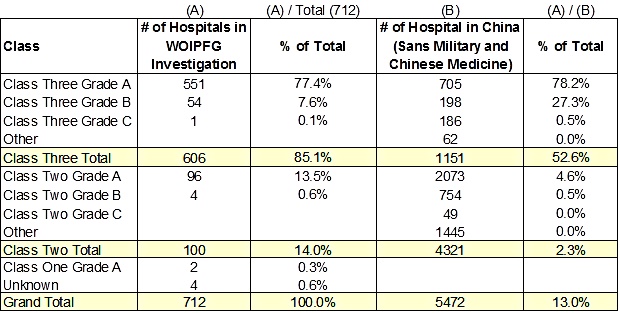
Table 5.1 712 Hospitals Investigated by WOIPFG
According to the Bureau of Medical Administration (BMA), part of the National Health and Family Planning Commission of China, there are 1,151 Class Three hospitals and 4,321 Class Two hospitals in China as of July 19, 2015[341].The BMA numbers don’t include any military-owned or Chinese medicine hospitals. The WOIPFG’s hospital count of 712 is 53% of all Class Three and 2% of Class Two hospitals. Class Three hospitals are usually general or highly specialized hospitals in big cities with 500 or more beds.
3. Transplant Volume from Official Hospital Data (With Missing Years)
Extensive research of the 712 hospitals’ official data yielded a total 225,815 kidney and liver transplants performed through December 2014. This translates to, on average, 317 transplants per hospital. These are official numbers released by the hospitals or academic papers published by their doctors.

Table 5.2 Transplant volume from official hospital data, with some years missing
We started investigating the number of transplants performed by each of the 712 hospitals in February 2014. Many Chinese hospitals stopped updating their numbers or deleted relevant web pages after forced organ harvesting was first exposed in 2006.
4. Filling in Missing Years
The 225,815 figure includes various missing years for different hospitals. To fill in the gaps, we relied on the following sources:
· Statistics and news reports found on the hospitals’ websites.
· Medical essays and papers that state the number of organ transplants performed by the hospital in different times.
· Old data for hospitals from www.archive.org.
· Phone interviews with doctors from these hospitals.
The revised total number after filling in missing years between 2000 and 2014 (inclusive) totals to 401,678 transplants.
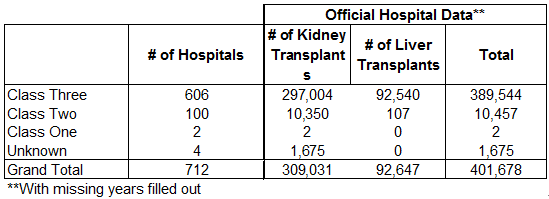
Table 5.3 Estimated transplant volume from official hospital data, with missing years filled in
Four hundred thousand seems like a large number. However, one should consider the total number of Falun Gong practitioners prior to the persecution, which was conservatively 70 million. (According to the Chinese Department of Public Security, the number of Falun Dafa practitioners grew to somewhere between 70 million and 100 million between May 1992 and July 1999.)Four hundred thousand is less than 1% of the total number of practitioners, or 0.2% ~ 0.6% of total kidneys and livers, assuming one (70 million) or all three (70 million x 3) organs are used for transplants.
Adjustments, or filling in transplant volumes for missing years, were done based on the following sources and methods:
. Additional findings
. Interviews
. Medical papers
. Minimum regulatory standards
. Assuming a low annual rate based on known years

Table 5.4 Summary of adjustment method for kidney transplant data

Table5.5 Summary of adjustment method for liver transplant data
5. Transplant Volume Did Not Decrease After 2006
At first glance, the assumption of a constant annual transplant rate seems aggressive. We believe it is reasonable to make the constant rate the lower bound, however.
The international community holds the opinion that after a sudden surge in transplant operations in Chinese hospitals around 2006, the numbers went down dramatically. This was, in fact, a false appearance. Upon examining the individual hospitals, we saw that the number of organ transplants at many of them actually went up.
Our observation is consistent with that of David Matas. In State Organs: Transplant Abuse in China (published in 2012), Mr. Matas wrote that since his and David Kilgour’s report was published in July 2006, “matters had gotten worse, that there had been an increase of sourcing of organs from Falun Gong practitioners.[342] ”
When the suppression of Falun Gong began in July 1999, millions went to Beijing to petition for justice[343]. The Chinese regime responded by detaining them and forcibly transporting petitioners back to their hometowns.
As of April 2001, the Beijing Public Security Bureau had reportedly arrested and registered 830,000 Falun Gong practitioners who had gone to Beijing to petition. Most of these practitioners were detained and sent back to their hometowns to be punished. This gives a sense of the scale of the numbers of detained practitioners.
A significant number of them refused to identify themselves, out of concern that their families or workplaces would be implicated. Many of these practitioners were then sent off to labor camps and detention facilities across China, potentially to serve as the initial population for what was to become a live organ bank.
The communist regime first harvested organs from political prisoners decades before the persecution of Falun Gong practitioners started[344], but the sheer number of Falun Gong practitioners and the policy of a nationwide suppression made such large-scale harvesting possible.
When Jiang Zemin launched the suppression campaign in 1999, his directives were to: ruin Falun Gong practitioners’ reputation, cut off their finances, and extinguish them physically. Organ harvesting fits the third part: extinguish them physically and make some money along the way.
Since harvesting Falun Gong practitioners’ organs is a “political task,” transplant hospitals are under pressure to perform. Our investigations of some of the 712 hospitals, such as the PLA’s (People’s Liberation Army)No. 309 Hospital, Tianjin First Central Hospital and Fuzhou General Hospital of Nanjing Military Region, reveal that internal rankings exist among the hospitals involved.
These internal rankings incentivize hospitals to become “top performers.” In the Party system, monitoring by the 610 Office (an extralegal security agency created by the Party to eradicate Falun Gong practitioners) and distributing political pressure among the hospitals are common organizational methods.
6. Minimum Regulatory Standards
That said, we should offer a word of caution regarding minimum regulatory standards: their existence does not mean that WOIPFG believes all Chinese hospitals strive to meet the minimum standards. In an environment that lacks other data, we believe that minimum regulatory standards can serve as useful and conservative data points, when we know the hospitals within each ranking are fully capable of doing more.
Below is a list of such standards:
· Class Three Grade A hospitals: minimum five organ transplants per year (Ministry of Health)
· Liver/kidney transplant hospitals designated by Ministry of Health: minimum 20 liver transplants and 30 kidney transplants
· Minimum 10 liver transplants and 50 kidney transplants per year (To qualify for liver or kidney medical projects approved by Guangdong Provincial Medical Association)
7. Hospitals with Kidney Transplant Count Adjustments
The table below presents kidney transplant volume adjustment levels by class:
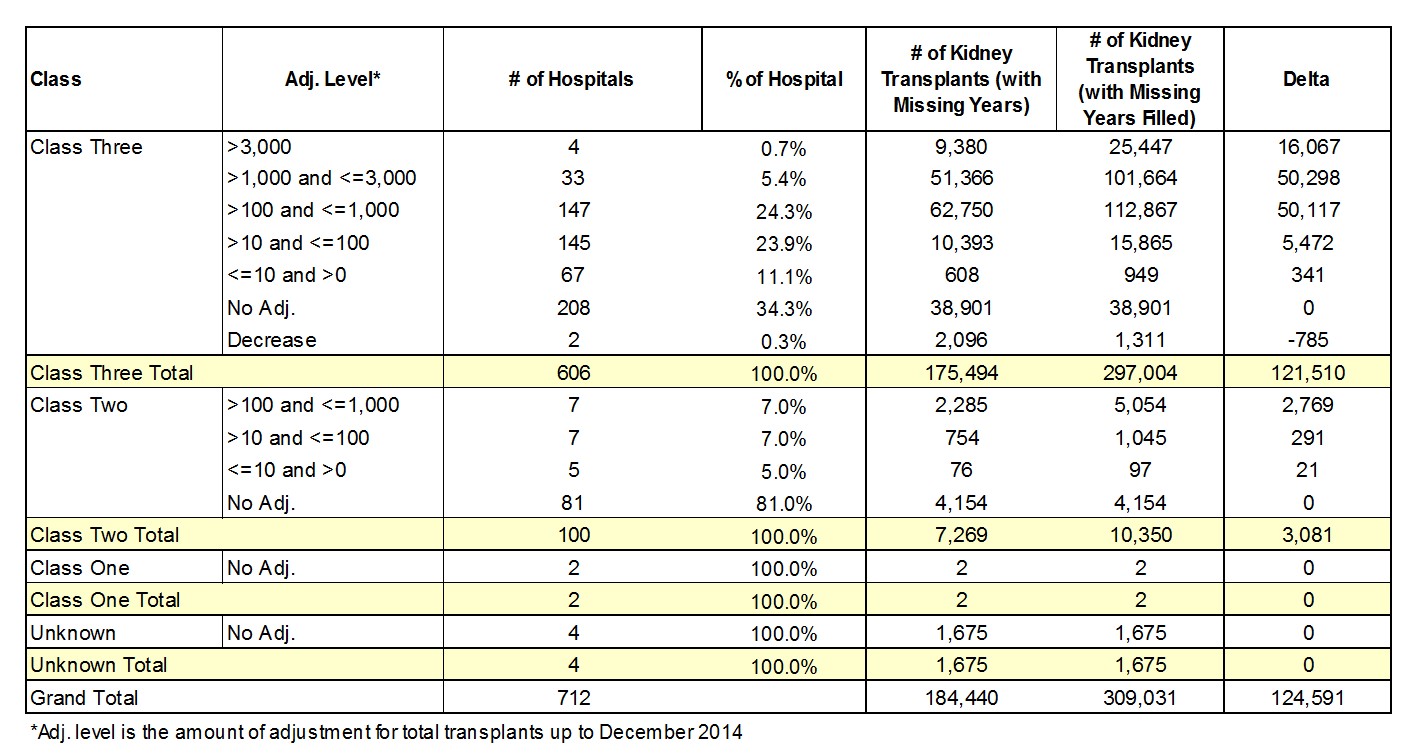
Table 5.6 Kidney transplant volume adjustments by class
8. Hospitals with Liver Transplant Count Adjustments
The table below presents liver transplant volume adjustment levels by class:

Table 5.7 Liver transplant volume adjustments by hospital class
II. State-Level Military Organ Transplant Centers: Cases Where Data Has been Deleted and Tampered With and Websites Are No Longer Updated
1. Nanfang Hospital of Southern Medical University (Formerly First Military Medical University): Suspected of Reducing the Actual Number of Kidney Transplant Operations by 5,000
This is a Grade 3 Class A hospital. In August 2004, together with Southern Medical University, Nanfang Hospital was handed over by the military to Guangdong Province[345]. The hospital was designated to conduct kidney and liver transplantation by the Ministry of Health on May 23, 2007[346]. In 2004, the hospital was designated by Guangdong provincial government as a Grade A kidney transplant hospital, Grade A liver transplant hospital and Grade B cardiac transplant hospital.
In March 1995, Jiang Zemin conferred the honorary title “Model Medical Division in Providing Service to Overseas Chinese” to the hospital. It is the only military hospital that provides “international medical services.” The hospital’s organ transplant capabilities have become a means for the CCP to expand its influence to overseas Chinese and countries worldwide for its “united front” work. By the end of 2006, “nearly 70,000 visitors from more than 70 countries and regions had visited the hospital to be either hospitalized or receive physical examination.[347]”
Kidney Transplant: Suspected of Tampering With Official Data From December 2001 to August 2003, an Average of 501 Cases per Year
1) According to the hospital’s official website, from 1978 to July 2009, the hospital completed a total of more than 3,800 cases of kidney transplant, ranking No.2 in China and No.1 in Guangdong Province[348]. The web cache showed that this information was released prior to July 2009.
2) According to an article titled “Guangdong Province Accomplished an Average of Three Kidney Operations per Day, Accounting for 1/5 of Total Number of Kidney Operations in the Nation,” which was published in the Yangcheng Evening News in August 2003, Yu Lixin, physician in charge of kidney transplant at the hospital, stated: “Since the completion of the first case of kidney transplant in 1978, by August 2003, we had conducted more than 3,000 cases of kidney transplant. In recent years, we have been performing around 250 cases of kidney transplant annually.[349]”
3) However, in a medical paper titled “Development of China’s Clinical Kidney Transplant,” which was published in the Medical Journal of the Chinese People’s Armed Police Forces in 2004, we found that by as early as November 2001, the hospital had already conducted 2,123 cases of kidney transplant. From this, it’s easy to deduce that from December 2001 to August 2003, the hospital performed more than 501 cases of kidney transplant annually. As to Yu’s own statement of “an average of 250 cases annually,” he arrived at the average number by taking into account the additional years prior to 2001. Thus he was attempting to hide the fact that the number of kidney transplant surged by 100 percent since the end of 2001.
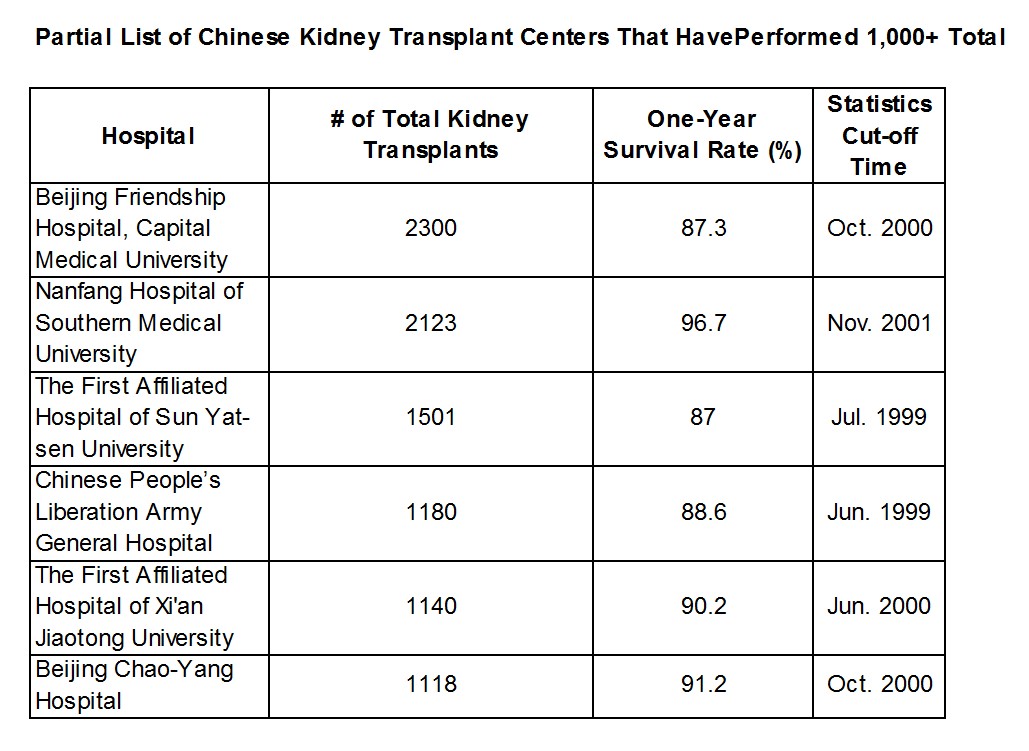
Figure 5.1 Partial list of Chinese organ transplant centers that have performed over 1,000 total kidney transplants
4) We have observed that from 2000 to 2006, all of the hospitals under investigation saw an upsurge in terms of the number of kidney transplant operation performed. However, even if we assume that this hospital performed 501 cases of transplant per year, the hospital should have conducted a total of 3,800 cases of operations by March 2005, instead of July 2009, which was four years later.
5) To fill in the missing figures, by December 2014, the hospital should have conducted at least 8,680 cases of kidney transplant.
6) Taking into account the fact that the sharp increase in the number of kidney transplant in China had only just begun around the time of August 2003 and had not reached the peak time, we believe that the actual number of kidney transplant operated by this hospital are even more shocking.
Liver Transplants: Figures Not Released to the Public; Hospital Suspected of Tampering With Liver Transplant Figures After 2006
1) This hospital has not released official figures on liver transplants to the public. We were only able to find complete figures from released medical papers: “From August 2004 to December 2011, the department performed a total of 253 cases of orthotopic liver transplant (among which, 2 cases were returning patients who had received a transplant operation already)[350].”
We are skeptical about the authenticity of these figures. This is because the figures were released after 2006, with an average of less than 34 cases per year, which seems not to be in line with the scale of the hospital and the fact that the hospital has a large number of readily available “donors.”
2) According to the WOIPFG’s investigation report in 2006, the response of a surgeon who performed liver transplant at the First Affiliated Hospital of the First Military Medical University (Nanfang Hospital in Guangdong) is as follows: Try your best to come to our hospital. We operate on Saturdays. We have many donors in April. Next week we will have several batches of donors. … We operate on nearly 100 cases every year. Come as soon as you can. You can come on Saturday and Sunday as well[351].
Given the surgeon’s estimate of “nearly 100 cases per year” we shall try to fill in the missing figures on liver transplant for this hospital. The hospital began conducting liver transplants in February 2003[352]. By December 2014, assuming a constant rate, this hospital should have conducted approximately 1,191 cases of liver transplant, not the official figure of 253 cases.
2. Changhai Hospital of the Second Military Medical University: Chief Physician of Kidney Transplant Committed Suicide by Jumping From a Building; Website Data Was Removed
In 1993, the hospital became one of the first Grade 3 Class A hospitals in China[353]. On August 1, 2013, the hospital was designated to conduct kidney and heart transplants by the National Health and Family Planning Commission[354]. Jiang Zemin once wrote an inscription for the hospital[355].
Since the suicide of the hospital’s chief physician of kidney transplant, Li Baochun, the hospital removed the majority of its online data on transplant operations. According to an article published in the newspaper Zhong Guo Kuai Bao on May 24, 2007, “On May 4, sometime in the afternoon, physician Li Baochun, who had been suffering from depression, jumped to his death from the 12th floor of a building at Shanghai Changhai hospital—the same floor on which he used to perform kidney transplants and wait for kidneys from donors.” Li Baochun, who was 44 years old at the time of death, was a renowned nephrologist, a member of the Chinese Dialysis and Transplant Association, director of the Nephrology Department at Changhai Hospital, chief physician, professor and doctoral-student supervisor. Li Baochun would never know that his final departure “embarrassed” his hospital[356].
This hospital has ample kidney sources: the webpage of the hospital’s Department of Urology states: “1. Quality kidneys available; speedy recovery following kidney transplant; 2. Ample kidney sources; short wait time for transplant.”
(http://www.chhospital.com.cn/dept/dept4/special/special4.htm) The original article has been removed. However, the article may still be found at the archived website (see the figure below)[357]:

Figure 5.2 Descriptions on the kidney transplant operations at Changhai Hospital
Our investigation also suggests that since 2006, the surgeons at this hospital have fabricated figures on kidney transplant in their published medical papers: “From 1999 to 2004, we performed 231 cases of kidney transplant[358].” This averages to only 40-plus cases per year, which contradicts with the hospital’s claim of having ample kidney sources.
Since our investigation did not find any absolute number evidence, we shall use the estimate of 45 cases of transplant performed per year. By December 2014, we estimate the hospital would have performed a total of 681 cases of kidney transplant.
3.Xinqiao Hospital of the Third Military Medical University: Fabricated Figure on Kidney Transplant Is Approximately 2,000 Less Than Actual Figure
This was one of the earliest “Grade 3 Class, A hospitals” in China[359]. It was designated to conduct kidney transplant by the Ministry of Health on May 23, 2007[360].
The hospital has already conducted liver transplants. According to the hospital, as it proceeds with clinical works, it will further expand on conducting combined pancreas-kidney transplant and pancreas transplant, be proactive in conducting liver transplant, and create favorable conditions for conducting small intestinal transplant[361]. The hospital has conducted several dozen cases of orthotopic liver transplant, combined pancreas-kidney transplant and pancreas transplant[362].
Tampering With Publicly Available Figures Multiple Times; Figures Went Down Instead of Up:
Page 157 of the hospital’s paper document “A Brief History of the Department of Urology of the Military Nephrology Center” states: “By 2002, the hospital had conducted 2,590 cases of kidney transplant.” “Since 1998, the hospital has been conducting an average of 180 cases of kidney transplant per year. On one occasion, the hospital conducted 24 cases of kidney transplant on one single day.[363]” This piece of information was most likely published around 2003 or 2004.
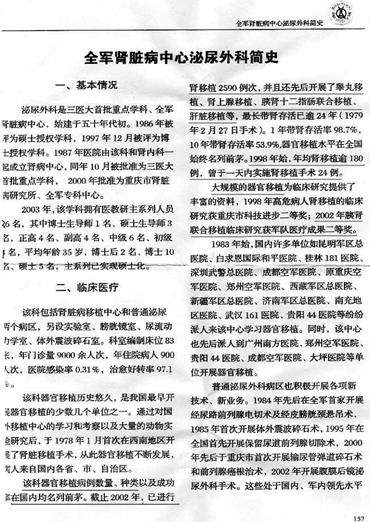
Figure 5.3 A Brief History of the Department of Urology of the Military Nephrology Center
According to a report in Chongqing Medical Journal, from January 1978 to January 2007, this hospital implemented 3,102 cases of cadaveric renal transplantation[364].
The official website claimed the following: As of September 30, 2008, the hospital has performed more than 3,300 cases of renal transplantation and launched renal, testicular, adrenal transplantation, and the combined transplantation of duodenum, pancreas and kidney[365]. Comparing to the number in the Chongqing Medical Journal report, there were 192 more cases performed between January 2007 and September 2008, with an average increase of 110 cases per year.
In February 2011, the president of the hospital, Wang Weidong, claimed, “We have performed cumulatively more than 3,600 cases of kidney transplant.[366]” Between September 2008 and February 2011, there was an increase of 300 cases, which was a reasonable number considering the scale of the hospital.
However, the number of transplant cases reported by the Xinhua Net in July 2012 was less than the above figure. Huang Chibing, director of No. 2 Urology Division at Xinqiao Hospital of the Third Military Medical University, said that so far the hospital had performed more than 3,400 cases of kidney transplantation[367].So from 2002 to the end of December 2014, if the hospital performed 200 cases each year, there would be approximately 5,190 cases of kidney transplantation in the hospital.
The number of liver transplantation at this hospital was unknown. However, it is one of the four hospitals in Chongqing that carried out DCD (Donation after Cardiac Death) transplantation[368].
Based on the minimal requirement to be a DCD hospital, which has to perform at least 20 cases of liver transplants per year, the lowest total number of liver transplant cases would be 146 between 2000 and April 2007.
III. Medium-sized Military Hospitals have Falsified Data, Removed Related Webpages, and Stopped Updating New Cases
1. The PLA No. 175 Hospital of the Nanjing Military Region (also known as the Affiliated Southeast Hospital of Xiamen University) removed critical webpages
The PLA No. 175 Hospital of the Nanjing Military Region is a Grade 3, Class A hospital[369]. In 2007, it was disqualified in the audit of the Ministry of Health.
The hospital successfully carried out the military’s first kidney transplant surgery in March 1977. The hospital also carried out the first living-donor kidney transplants in southern Fujian region and the first combined heart-lung transplant in the province. It has well-developed technologies in various tissue and organ transplant surgeries, such as kidney, liver, heart, cornea and skin transplants, as well as microsurgery[370]. By 2008, it had carried out nearly 400 cases of kidney transplant surgery[371]. The related webpage has been removed now.
2. People’s Liberation Army No. 181 Hospital tampered with data, reporting a number that is much lower than the actual number of transplants, and did not update the webpage
The People’s Liberation Army No. 181 Hospital is a Grade 3 Class A hospital[372]. It was designated to carry out kidney transplants by the Ministry of Health on May 23, 2007[373].
Since 2000, the annual volume of kidney transplantation reached more than 150 cases. The hospital started to carry out kidney transplants in 1986. By January 2009, it had accumulated more than 2,000 cases[374]. The related webpages have not been updated since February 2009[375] to April 2015.
Supplementary data: From 2009 to December 2014, the hospital completed 900 cases of kidney transplantation. The total number of kidney transplants is 2,900 cases.
1) According to the official website the Department of Hepatobiliary Surgery started liver transplantation in 2002 and now has performed more than 60 cases[376].
2) The evidence from the WOIPFG telephone survey recordings reveals the possibility of a significantly higher number: “We also do liver transplantation. This year we did more than 20, operated by Southwest Hospital Specialist. We provided donors. It only takes one or two months. We are confident to get the donor. If an outside specialist brings in a patient, we will charge more.” According to the estimate of half a year with more than 20 cases of liver transplantation, then it should be more than 40 cases throughout the year. If calculated based on 40 cases per year, from 2002 to 2014, there should be 520 cases of liver transplantation.
3. The PLA No.452 Hospital (aka. AirForce Chengdu Hospital): Data-related webpages have been removed from the official website. The chief physician admitted to using Falun Gong practitioners as donors
A comprehensive Grade 3 Class A hospital[377], on May 23, 2007, it was designated by the Ministry of Health as a hospital qualified to carry out kidney transplants[378].
In 2006, the WOIPFG exposed that related data pages on the official website had been deleted.
1) From January 1990 to June 2000, the hospital performed 107 cases of allograft kidney transplantation[379].
2) However, in 2009, Xinhua Net reported that planned and prepared by Zhang Cong, the PLA No. 452 Hospital quickly set up a kidney urology center, and the number of cases of kidney transplantation became the largest in Sichuan Province[380].
3) In evidence from the WOIPFG telephone recordings, Director Xu (Yahong), a veteran surgeon in the Air Force hospital with 22 years of experience, said that from the mid to late 1980s, the hospital introduced kidney transplant techniques, and he himself had operated on more than 500 cases. During the last two to three years, more than 100 cases were performed per year on average.
4) The WOIPFG investigation recorded the hospital’s chief physician speaking of using Falun Gong practitioners as organ donors:
Director Xu (Yahong) said that after mid-May, there were a number of kidneys, voluntary donors, to provide young and healthy Falun Gong practitioners’ organs[381].
On average, this hospital performed more than 100 transplants per year, from 2000 to the end of 2014, and completed at least 1,500 cases.
4. The People’s Liberation Army No. 201 Hospital removed data from the official website: more than 30 cases per year with eight years to complete the more than 200 cases
The hospital does not pass the qualification to perform organ transplants. However, it has been working on kidney transplants.
1) On November 24, 2007, Minghui.org reported that the hospital had performed more than 30 cases of kidney transplant per year. It operated on at least 200 cases since 1999. Zhen Changchun, director of the Urology Department and attending physician, has performed 254 cases of kidney transplant and has trained several "transplant doctors." The Urology Department raised profits of over more than 5 million yuan annually for the hospital[382].
2) After the Minghui.org report was made public, the webpage was deleted.
3) The WOIPFG data obtained from published medical papers only represented a small part: from 1990 to 2006, the hospital implemented 45 cases of renal transplant[383].
IV. The Ministry of Health-Designated National Transplant Centers Falsified Data, Deleted or Stopped Updating Webpages
1.Tianjin First Central Hospital: largest global transplant center completed about 10,000 liver transplant operations
This is a comprehensive Grade 3 Class A hospital specializing in organ transplantation[384]. On May 23, 2007, the Ministry of Health approved its qualification to perform liver and kidney transplantation[385].
Its Organ Transplant Center was established by Shen Zhongyang in 1998. The Tianjin Organ Transplant Institute was set up in 2002. It claims to have the largest domestic professional transplant team, capable of transplanting liver, kidney, pancreas, small intestine and heart. It is the largest organ transplant center in Asia[386].It claimed that due to organ-supply shortage, since 2007 the Institute has been actively conducting live liver transplant and live kidney transplant. So far, it has ranked top in the number of live liver transplantations in China[387].
Liver Transplant: Data Tampered With, Actual Number Over 10,000
The official website gave fraudulent statistical data. The number of liver transplantations through the end of 2009 was reduced by at least 1,200.
1) According to hospital’s official website, by 2009, over 3,300 liver transplant operations had been completed[388].
2) The 2010 Yan Huang World magazine article titled "Shen Zhongyang Led His Team to Climb World Medical Peak" stated: By December 31 of last year, the Oriental Organ Transplant Center had completed 4,590 liver transplants.[389]"
3) According to a "China Liver Transplant Registry" (CLTR) report, by the end of 2010, organ transplant teams in Tianjin First Central Hospital and Armed Police General Hospital led by Shen Zhongyang had completed total 6,270 surgeries. They assisted 66 medical institutions in 22 areas of our country to develop clinical liver transplant work.
In the same time period of Armed Police General Hospital: By December 2010, close to 1,500 liver transplants and 400 kidney transplants had been conducted[390]. Therefore, based on the CLTR report’s data, we estimate that 4,770 liver transplants were completed in Tianjin First Central Hospital by the end of 2010.
4) A news report in November 2010 in People Net: Tianjin Window supported the above data: From September 1998 till today, Shen Zhongyang’s team has been in the first place consecutively for 12 years, with the largest annual number of liver transplants in the nation. By the end of 2009, they had completed 4,590 liver transplants[391].
5) In summary, the official website tampered with data, reducing the number of liver transplants by at least 1,200 by the end of 2009.
Since 2010, Shen Zhongyang has personally attempted many times to reduce the number made public, but in a later interview, he eventually admitted that close to 10,000 liver transplants had been completed in the Orient Organ Transplant Center.
1) According to a report dated Jan. 27, 2011, in Guangming Net (the Web version of the CCP’s official newspaper Guangming Daily), in Shen Zhongyang’s medical career, he led the transplant center to create a miracle: nearly 6,000 successful liver transplants within 12 years[392].
2) An article from 2013 in China’s Soul magazine also reported: In his medical career, the president of Tianjin First Central Hospital, 51-year-old Dr. Shen Zhongyang, led the transplant center to create a miracle: over 5,700 successful liver transplants within 15 years[393].
3)On Jan 6, 2015, Chinese Technical Market newspaper published an interview article with the subtitle "Story of Tianjin Liver Transplant Expert Shen Zhongyang and His Medical Team." It stated that by the end of 2013, the Orient Organ Transplant Center ranked first in the nation for 16 consecutive years for the number of surgeries and the survival with quality of life. Shen Zhongyang has led his team to complete near 10,000 liver transplants[394].
4)The above interview article regarding near 10,000 liver transplants at Oriental Organ Transplant Center was published unchanged on the hospital’s official website[395].
5)On Dec. 10, 2014, Science and Technology Daily published an article titled "A Pioneer’s Work: Promote Voluntary Organ Donation Legislation, Interview with Professor Shen Zhongyang, President of Tianjin First Central Hospital (Part III)." The source included the same information: "So far, Shen Zhongyang’s team has completed near 10,000 liver transplants.[396]"
Considering the Orient Organ Transplant Center’s first-place national rankings for 17 consecutive years, the surgical numbers above can also be verified: In 2004, 507 liver transplants were conducted inside the hospital and 300 outside the hospital. In 2005, the surgery number reached 647; in 2006, it reached 655[397]. Doctors working there also claimed to have conducted 676 liver transplant operations in 2006[398].
Apparently the transplant number shows an increasing trend. In February 2006, Phoenix Weekly published an exclusive article with title "Investigation on Tens of Thousands of Foreigners Traveling to China for Organ Transplants." It stated: "As of December 16, 2005, the number of liver transplants conducted in the center was 597. Yet by December 30, the number increased to 650, that is, 53 liver transplants were conducted in two weeks." "Some patients’ family members told us that as many as 24 liver transplants and kidney transplants had been conducted in the center in a single day." If five transplants per workday, there would be over 1,000 transplants per year. Before the completion of the transplant center building in 2006, there were only over 120 beds; 500 beds will be added in the new building. Therefore, based on the assumption that transplants stayed relatively constant, after 2007 there were 1,000 transplants conducted annually, then until December 2014 they would have completed 10,000 liver transplants.
The Oriental Organ Transplant Center is suspected to be involved directly in forced organ harvesting:
In 2009, Tianjin Medical Journal introduced Shen Zhongyang: From January 2004 to August 2008, he participated in 1,600 liver extraction surgeries[399].
A great number of foreign organ transplant patients traveled to the Orient Organ Transplant Center to be treated, and their waiting time was extremely short:
It takes only 1.5 hours to fly from South Korea to Tianjin First Central Hospital, China’s largest organ transplant center. In 2005, over 360 South Korean patients received transplantation here, accounting for about 40 percent of all transplant operations[400]. The waiting time was initially about one week. However, with more and more foreign patients waiting for donors, waiting time increased to over three months in some cases[401] (by global standards of course, this is still an extremely short wait time).
The Orient Organ Transplant Center provided two successive emergent liver transplants within 48 hours:
They once gave a liver cancer patient surgery for 47 hours. After twenty-six hours without a liver, the patient survived and underwent the second transplant. This 60-year-old patient suffered acute fulminant liver failure and had been in coma for eight days without spontaneous breathing. To come for the liver transplant, relying on a ventilator, the patient had taken a charter flight from Taiwan[402].
Kidney Transplantation: Data Tampering Started in 2006
1) The official website states: "By 2009, 2,357 kidney transplants and 31 pancreas-kidney transplants have been completed[403]," while a doctor wrote in an academic paper that “from October 1998 to December 2011, we finished 2,572 kidney transplants[404].”
2) Web archives show that in this hospital, "by the end of 2004, a total of 1,500 liver transplants and over 500 kidney transplants had been completed.[405]"
3) Web archives show that by June 2006, a total over 2,100 liver transplants and over 1,300 kidney transplants had been completed[406]. Comparing with data above, we see an increase of 800 kidney transplants in one and a half years, i.e., 500 more kidney transplants per year.
4) In this hospital, "a record of 500 liver transplants and 300 kidney transplants was achieved in 2004. This was the first rank in the nation in terms of both the yearly liver transplant number and the yearly kidney transplant number. It also ranked the first in the world in terms of the yearly liver transplant number. [407]" "In the whole year of 2005, 647 orthotopic liver transplants, 436 kidney transplant, and multi-organ transplantations, including 21 liver-kidney transplants and 2 pancreas-kidney transplants, were completed in the Orient Organ Transplant Center. [408]" In other words, the trend is towards a continuous increase in liver transplants.
5) From the information above, we can see that starting from 2006, the hospital tried to tamper with data because according to its own statistic data, by the end of 2005, more than 2,147 (= 1,500 + 647) liver transplants were completed. In 2006, the hospital’s official number was 665 (or 667 from another source), so by the end of June 2006, more than 2,400 liver transplants should have been completed.
6) In April 2009, North Net reported: "In the past 4 years, their annual numbers of liver and kidney transplants were both the first in the nation.” This data can also be found in the webpage archive of this hospital’s organ transplant center[409]. It shows that from 2005 to 2008, there was a rising trend of kidney transplantation.
7) After 2007, the annual liver transplant number was on average over 800, higher than in 2005 and 2006, so we would expect to see a similar trend in the number of kidney transplants at this hospital.
8) Assume starting from 2006, 500 kidney transplants per year (a reasonable estimate because in 2005 alone, including multi-organ transplantation, the number was 436 + 21 + 2 = 459), till December 2014, when a total of 5,436 (= 500 + 436 + 500 × 9) kidney transplants were conducted in this hospital.
2. Beijing Chao-Yang Hospital, a subordinate to Capital Medical University, gave fraudulent data about its kidney transplant statistics on its official website, claiming to have conducted 3,000 transplants. We believe the evidence suggests that the actual figure should be twice that.
According to the current website of Beijing Chao-Yang Hospital, the hospital conducted China’s first simultaneous pancreas-kidney transplantation in 1999, and has conducted over 3,000 kidney transplants so far[410]. By December 2006, the hospital had conducted over 2,000 kidney transplants[411].
However, after looking up reports on People.com.cn and webpage archives, we found that the hospital had intentionally tampered with its reported data. The hospital should have conducted over 3,000 kidney transplants by 2002, instead of 2006 when, in December, live organ harvesting of Falun Gong practitioners was first revealed. “[The hospital] had conducted 269 kidney transplants in 1998, 303 transplants in 1999 and 348 transplants in 2000. It conducted the most kidney transplants in China for three consecutive years.[412]”“By August 25, 2000, Beijing Chao-Yang Hospital, a subordinate to Capital Medical University has conducted over 1,000 kidney transplants in 9 years.[413]” “Between September 1991 and December 2000, our hospital conducted 1,100 allograft renal transplantations, among which 12 are simultaneous pancreas-kidney transplantations.[414]” “By December 2001, [the hospital] has conducted over 1,400 kidney transplantations and 15 simultaneous pancreas-kidney transplantations[415]” (the figure below).
These reports show that the number of kidney transplants conducted by Beijing Chao-Yang Hospital were constantly increasing. During the period of one year and three months before 2001, about 400 kidney transplants were conducted. This gives an average of 320 transplants per year, which is consistent with the average of 307 transplants per year between 1998 and 2000.
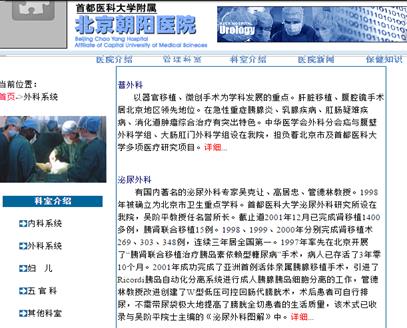
Figure 5.4 : Web page archive of the report showing Beijing Chao-Yang Hospital had conducted over 1,400 kidney transplants by December 2001.
Assuming that the hospital conducted 320 kidney transplants annually in the years after 2002, about 3,000 transplants would have been performed by December 2006, and approximately 5,500 transplants would have been performed by December 2014.
Liver transplant: No update or only unclear reports available after April 2006:According to the hospital’s official website, since Beijing’s first liver transplantation was conducted in July 1999, “[The hospital] has conducted 142 liver transplants by November 2004, with an average of 35 transplants per year.[416]” During the same period, the hospital dean Li Ning was reported to have said that the hospital conducted over 170 liver transplants in five years. This figure can be taken as an initial-stage statistics by the end of 2004[417].
However, after 2006 (when live organ harvesting was reported by foreign media for the first time), the hospital gave no update or only fraudulent data on the number of conducted liver transplants. For example, according to scientific papers authored by surgeons of the hospital, there were six liver re-transplantations among all 164 liver transplants between July 1999 and December 2004[418].Between January 2005 and September 2007, 180 orthotropic liver transplantations were conducted[419]. These reports give an estimate of over 344 liver transplants conducted by September 2007. Assuming an annual average of 65.6 liver transplants corresponding to the years between 2005 and 2007, about 426 liver transplants should have been conducted by December 2008. This is not consistent with a cached online report released in April 2009, which claimed that over 300 liver transplants had been conducted by that time[420]. (Here we reasonably take the data as an update till the end of 2008.) By August 2012, the hospital’s official website still claimed “over 300 liver transplants had been conducted.[421]” According to a snapshot of the website in 2013, “So far our sector had conducted over 500 liver transplants.[422]” We make an estimate of about 50 liver transplants per year between October 2009 and December 2014, which gives 706 liver transplants conducted by December 2014.
3. Peking Union Medical College Hospital: Led by Huang Jiefu, removed all statistics from various sources, and never updated its website
Although this is the most famous hospital in China, no publication about the hospital’s liver transplantation can be found in any Chinese academic search engines. The hospital’s website has been scrubbed of all web pages with any information about the number of liver transplants. Any statistics of kidney transplants have not been updated for 10 years. The hospital has a strong surgeon team with degrees from overseas. There is no reliable way for us to estimate how many liver transplants the whole hospital has conducted in over a decade.This lack of transparency is highly significant because the liver transplantation sector of the hospital is led by Huang Jiefu, pioneering surgeon particularly in kidney extraction, the recipient of honorary degrees from top Western universities, and the current spokesman in charge of selling the idea to the West that China has dramatically reformed its harvesting system in recent years.
Kidney transplantation: No data update for 10 years
In evaluation of organ transplantation service made by the Ministry of Health in 2006, “Our kidney transplantation sector has a long history with modern techniques and effective therapy; the sector is ranked the second overall in the Beijing area, and is qualified for kidney transplantation service with an excellent performance.[423]” An introduction of the hospital’s urinary surgery in November 2004 on Daifumd.com[424]said, “Nearly a thousand allograft renal transplantations have been conducted.[425]”
However, so far the hospital’s website still says, “Nearly 1,000 allograft renal transplantations have been conducted.[426]”Google snapshot confirms that Web page with the same description was saved on June 7, 2005. Clearly, the hospital never updated the statistics after November 2004.
Yet we still need to make an estimate. Assuming an average of 100 transplants per year, the hospital had conducted no less than 2,000 kidney transplants by December 2014. Considering that Beijing’s No.1 kidney transplantation hospital, Chao-Yang Hospital, conducts 300 transplants per year, Union Medical College Hospital as the No.2 (evaluated by the Ministry of Health) may conduct close to 200 kidney transplants per year. This suggeststo us that 3,000 kidney transplants in total is a reasonable assumption.
4. Fudan University’s subsidiary Zhongshan Hospital showed a pattern of explosive growth in transplants previous to 2007, stopped updating its website after 2008, and began giving fraudulent data. In 2006, a doctor admitted that the facility’s organ source was Falun Gong practitioners.
The hospital is a Grade 3 Class A hospital[427].On May 23, 2007, the Ministry of Health issued the hospital a certificate to perform liver, kidney and heart transplantation[428].The hospital is the only one in Shanghai that possesses certificates for all these three kinds of transplantation. An organ transplant center was founded in the hospital on Oct. 30, 2001[429].
1) A Sina report in December 2003: The Organ Transplant Center of Fudan University conducts over 100 transplantations per year at an annual growth rate of over 50 percent. On Dec. 8, 2003, in collaboration with the world’s largest organ transplantation institution, the center founded “Fudan University, Zhongshan Hospital-University of Pittsburg, Thomas E. Starzl Transplantation Institute Cooperation Center.” The center expects “better performance in the organ transplantation field” through the collaboration[430].
2) In August 2006 (the article originally received on Feb. 10), the hospital’s party secretary, associate dean and surgery director Qin Xinyu said in Chinese Hospitals magazine that Zhongshan hospital annually conducted about 400 transplantation surgeries of heart, lung, liver, kidney and other organs[431].
3) On Sept. 22, 2007, Zhongshan Hospital Journal published a special issue celebrating its 70th anniversary. The issue stated: “So far our hospital has conducted more than 2,000 kidney transplants, more than 570 liver transplants (among which 11 are live transplants), more than 200 heart transplants, 9 heart-lung transplants and 13 liver-kidney transplants; a rapid growth is seen in the number of organ transplantations each year; this will give new lives to more patients suffering from end-stage renal, hepatic, heart and lung diseases.[432]”
4) Online archives show that the hospital’s official website had the following introduction in 2005: “Zhongshan Hospital has overall conducted nearly a thousand kidney transplants, over 200 liver transplants, 107 heart transplants, 6 heart-lung transplants and 11 liver-kidney transplants. The number of organ transplants is rapidly increasing year by year.” The same Web page also says the following: “In 1991, our hospital successfully conducted China’s first kidney transplants for an 8-year-old child, who is already 22 right now,” which indicates the Web page was posted in 2005[433].
5) One should say all these reports are consistent with each other, as they reported the same trend.
6) Nevertheless, the hospital’s website had never been updated till July 24, 2014[434].The hospital began to give fraudulent data in its reports since 2008, such as insisting “the hospital has conducted about 1,000 kidney transplants in total.” Regarding the number of kidney transplants, the only change made on its website was to replace “nearly 1,000 transplants” with “over 1,000 transplants.” “Due to organ source shortage, the number of organ transplantations has been generally decreasing in China. Zhongshan Hospital still topped all other hospitals by conducting 60 kidney transplants of various types in 2004. In 2005, we conducted 153 kidney transplants. So far Zhongshan Hospital had conducted over 1,000 kidney transplants in total.[435]”
According to the 70th-anniversary report in 2007, “the number of organ transplants is rapidly increasing year by year.” Even if we don’t use an annual growth rate of 50 percent and only assume that the number of kidney transplants grows by 400 per year, ZhongshanHospital would still have conducted about 5,000 kidney transplants over the years. This estimate does match the hospital’s leading role in this field in China since its first kidney transplant in 1974.
A doctor of the hospital admitted that the organ source was Falun Gong practitioners:In a WOIPFG’s telephone investigation, a doctor at Zhongshan Hospital’s Liver Transplant Center was asked, “Do you have organs from people such as Falun Gong (practitioners)?” He replied, “All we have here are of this kind.[436]”
V. Medium-sized Hospitals Accredited by Ministry of Health to Perform Organ Transplant Operations have Tampered with Data, Deleted Webpages and Stopped Updating Websites
1. The First Teaching Hospital of Xinjiang Medical University: More than 1,000 Kidney Transplants Performed, Only 300 Transplants Announced
1)Surgeons from this hospital published a research article in Volume 19, 2010 of Journal of Nephrology Dialysis & Transplantation, that “Between August 1999 and September 2008, 779 kidney transplants were completed.[437]”
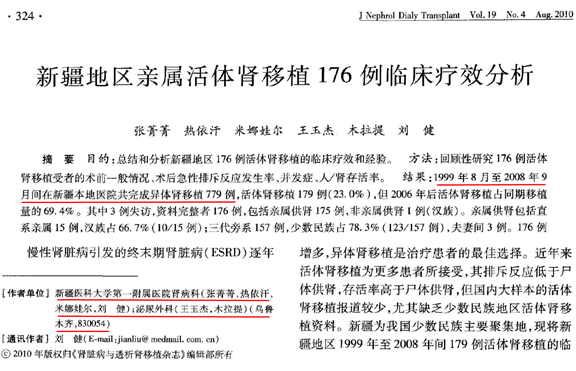
Figure 5.5 An article in No. 1 Affiliate Hospital of Xinjiang Medical University,August 2010
2) However, the hospital’s official website states that: “After 2001, we had more experience in kidney transplants from both dead and living donors, and we have performed more than 300 kidney transplants.[438]” For the past two years, the website was not updated.
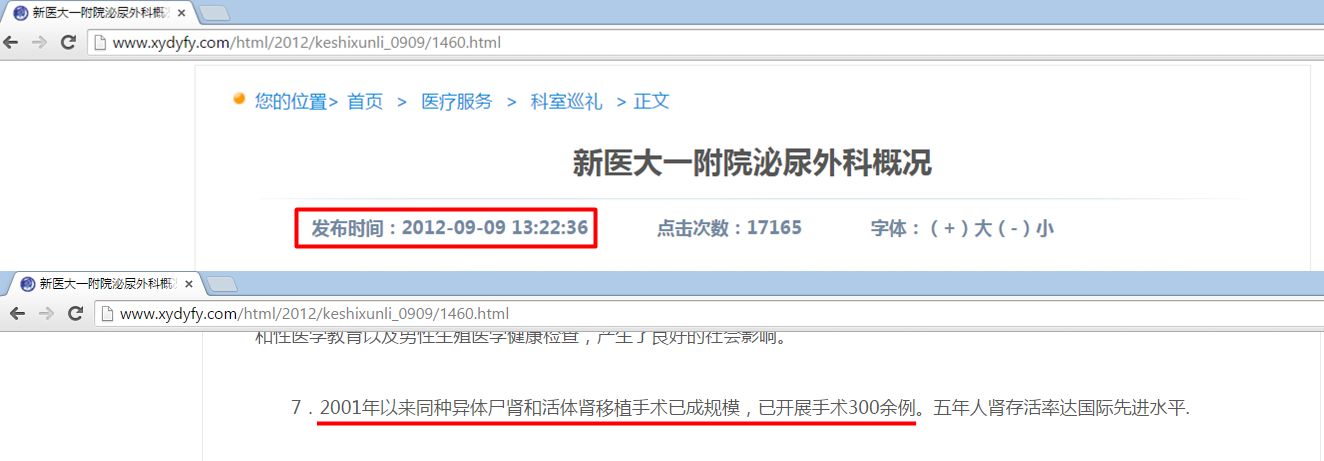
Figure 5.6 Web cache of No. 1 Affiliate Hospital of Xinjiang Medical University,released in September 2012
3)The above discrepancy indicates that the number of kidney transplants performed at this hospital increased sharply after 2001. Starting from October 2008, based on an average of 100 transplants a year, up to December 2014, we estimate this hospital should have conducted 1,304 cases of kidney transplants.
2. Guangdong Province’s Second People’s Hospital: Number of Transplants Dropped 700 in a Single Year
On June 30, 2014, the hospital’s transplant department website claimed, “Since our department was established in 1999, we have performed more than 1,000 kidney transplants. Director Liu Dong personally participated in more than 2,000 kidney transplants and liver transplants.[439]” “He conducted more than 600 kidney transplants from dead donors and over 20 liver transplants from dead donors as the chief operating surgeon.[440]”
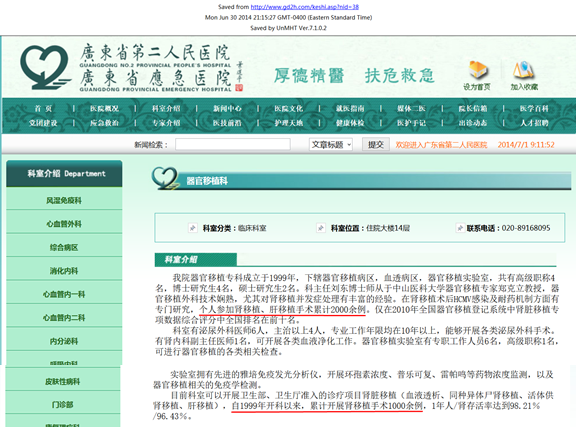
Figure 5.7 Web cache of Guangdong No. 2 People’s Hospital, released in June 2014
However, in February 2015, the hospital’s transplant department website claimed, “Since our department was established, we conducted more than 500 kidney transplants. Director Liu Dong personally participated in more than 1,200 kidney transplants, during over 200 operations he participated as the chief surgeon.[441]”
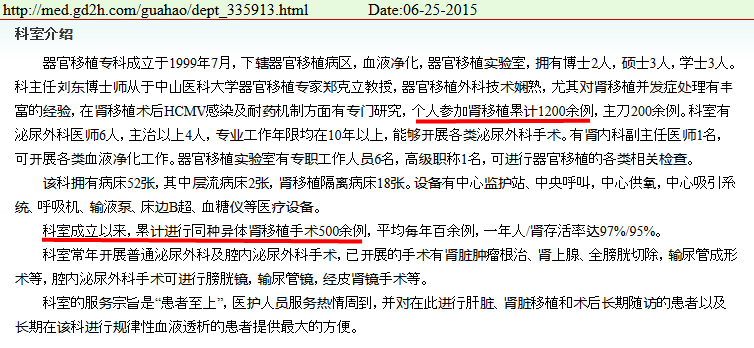
Figure 5.8 Web cache of Guangdong No. 2 People’s Hospital, released in June 2015
3. The First Affiliated Hospital of Jinan University’s Data has not been Updated in 5 Years; Number of Transplants Dropped from Previous Number -- 100 to 200 Transplants A Year; Total Number of Transplant Performed is Over 1,000; Organ Supply is Likely From Nanfang Hospital of Southern Medical University, Which has a Military Background.
The hospital (also known as Guangzhou Overseas Hospital, or First Clinical Medical College of Jinan University) is a Grade 3 Class A Hospital[442].
On May 23, 2007, this hospital was designated by the Ministry of Health as a kidney transplant hospital[443].In 2004, it became a Grade A kidney transplant hospital as designated by Guangdong province.
The Kidney Transplant Department was founded in 1997. In 2003, its name was changed to Organ Transplant Center, with a focus on kidney, liver and pancreas transplants[444].
From June 2010[445] till today, the hospital’s web page has not been updated. The data on the web page was collected years ago.
Since the first case of kidney transplant performed in 1993 till today, the transplant division has been active for more than ten years. This hospital has completed over 400 kidney transplants, and the transplant division has just begun to do liver transplants[446].
This hospital started liver transplants no later than December 2003[447]. The First Affiliated Hospital of Jinan University is on the list of Pilot Hospitals for Conducting Liver Transplants from Donations after Cardiac Death[448]. If there were 20 liver transplants a year, then from December 2003 to April 2007, the hospital completed 68 liver transplants.
Investigation by the WOIPFG found that the number of kidney transplants performed at this hospital is exceedingly large, and the donors are from Nanfang Hospital of Southern Medical University, which has a military background.
1) Ding Hongwen, the chief surgeon for kidney transplants at the Urology Department, disclosed the abnormal number of transplants performed at this hospital. He said (recorded conversation): “We used to perform around 100 or around 200 transplants every year, the cumulative number is now over 1,000. It’s difficult to say how many we perform each month. Sometimes we have eight transplants in one night. This is because it all depends on the supply of donors. If we can get a donor quickly, we can do the transplant in a little more than one month.[449]”
2)Peng Xuemei, an anesthesiologist who often worked with Ding Hongwen said, of all the one hundred some kidney transplants performed at this hospital, 70-80% were cases where the donor is unrelated to the patient, only a few were from patients’ relatives. There are many different channels of organ supply, including Nanfang Hospital of Southern Medical University, which has a military background.
(Recorded conversation) ”We contact Nanfang Hospital very often. If a patient here can make use of that kidney, he will make contacts to arrange it. Oftentimes, Nanfang Hospital obtained the kidney and delivered it to our hospital. I mean, we have our channels, but we cannot talk about them in public. Most are donors in Guangdong province. For example, if the kidney is to be delivered to our operation room this afternoon, he will notify the patient to come over in the morning. The longest cases, patients are here one week ahead of the transplant. Uh, one day, the patient comes over to get some preparation, then we start the operation.[450]”
Based on the conversation with Ding Hongwen (“around 100 to 200 transplants every year”), we estimate that on average this hospital performs 150 kidney transplants a year. Between 1997 and December 2014, the total number performed exceeded 2,000.
VI. A Pilot Hospital Performing Transplants from Donors of Cardiac Death Tampered with Data, Deleted Web Pages, and Stopped Updating Web Pages
Xi’an Gaoxin Hospital: a private hospital with many suspicious circumstances, including: an exceedingly large numbers of kidney transplants performed, flagrantly tampering with data, deleting its web pages, suspected of having performed on-site organ extraction, quick transplants. The hospital has a military background; the hospital admitted that during the 2008 Olympic Games, the Chinese Communist regime controlled donor supply. This hospital received the Grade 3 Class A qualification as late as 2008[451]. In 2007, because the hospital did not have the Grade 3 Class A qualification and was privately owned, it failed to pass the qualification review administered by the Ministry of Health[452].
It is a Sino-UK joint private venture. In 2011, this hospital became a pilot hospital for liver and kidney transplants from donors of cardiac death[453].
The current hospital website claims: Shortly after the hospital opened for business on October 27, 2002, we started to perform organ transplant operations. Between March 2003 and February 2007, we performed 232 cases of kidney transplants[454]. Between December 2003 and June 2006, we performed 31 cases of orthotopic liver transplants[455]. Fan Yuhui, director of the Urology Department, chief surgeon, the current vice president of Gaoxin Hospital, participated in more than 50 liver transplants[456].
In 2006, this hospital’s website had the following report: “The transplant team was led by Shi Bingyi, director of transplant center at the PLA No. 309 Hospital. In the two years following 2003, the team performed over 500 kidney transplants, more than 10 liver transplants. The team’s level of expertise is ranked at the top in the entire country.” This means that the hospital conducted more than 250 kidney transplants a year. In 2006, when the WOIPFG exposed the organ harvesting crimes inside China, this web page was deleted, but we are still able to find its backup web page on the Internet archive site[457].
The aforementioned deleted web page also contained the following statement: “The center currently performs more than 100 kidney transplants a year, with a success rate of 99%.[458]” This is a word game. The average number was actually 250 transplants a year, but the webpage used the phrase “more than 100”. We have often seen similar cases of wordplay while going through the deleted data from other hospitals.
Xi’an Gaoxin Hospital’s website also confirmed that surgeons from this hospital conducted on-site organ extraction in person, and there have been many such cases:“Be it hot summer or cold winter, 4 or 5 doctors extracted organs from the donor in a shabby van. They sometimes conducted 7 or 8 transplants in 24 hours, working day and night. Between 2002 and 2007, these surgeons made great achievements in organ transplantation. With limited manpower and medical equipment, the annual revenue generated by Gaoxin Hospital’s Urology Department exceeded 10 million yuan, which was a miracle. This number far exceeded the revenue of all “Grade 3 Class A” hospitals’ Urology Departments in Xi’an. In the entire Shaanxi Province, our revenue was comparable to that of the First Affiliated Hospital of Xi’an Jiaotong University and Xijing Hospital.[459]”
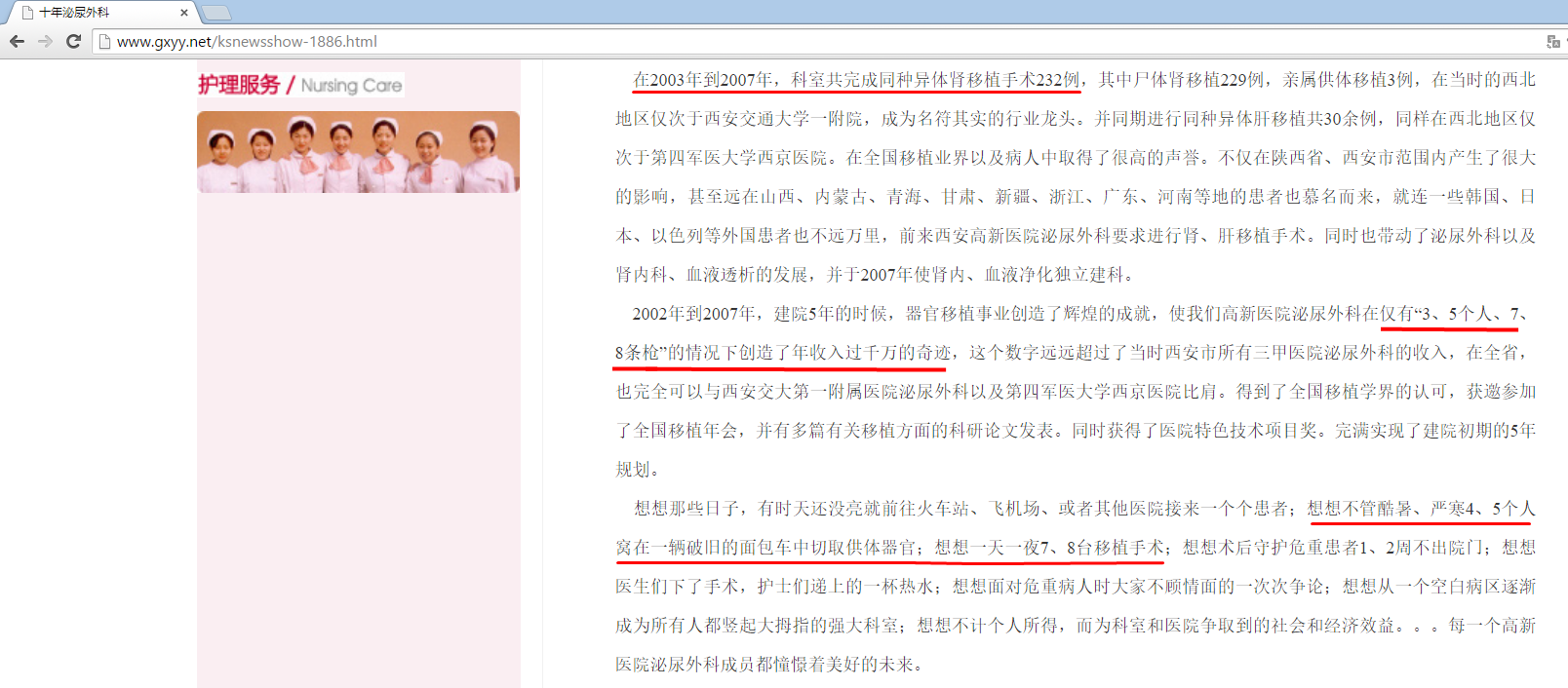
Figure 5.9 Web cache of Xian Gaoxin Hospital, released in September 2012
The new web page on the hospital website made it clear that the hospital was again tampering with data. “Between 2003 and 2007, the division completed 232 kidney transplants, of which 229 were from donors not related to the patient, three were from patients’ relatives. We are second only to First Affiliated Hospital of Xi’an Jiaotong University. Therefore, we have really become an industry leader in kidney transplants.” If Gaoxin Hospital had 46 kidney transplants a year, it would merely be a small fraction of the number of cases performed by the First Affiliated Hospital of Xi’an Jiaotong University; there is no way Gaoxin Hospital can be called an industry leader. Gaoxin Hospital’s tampering with its data ultimately resulted in a farce.
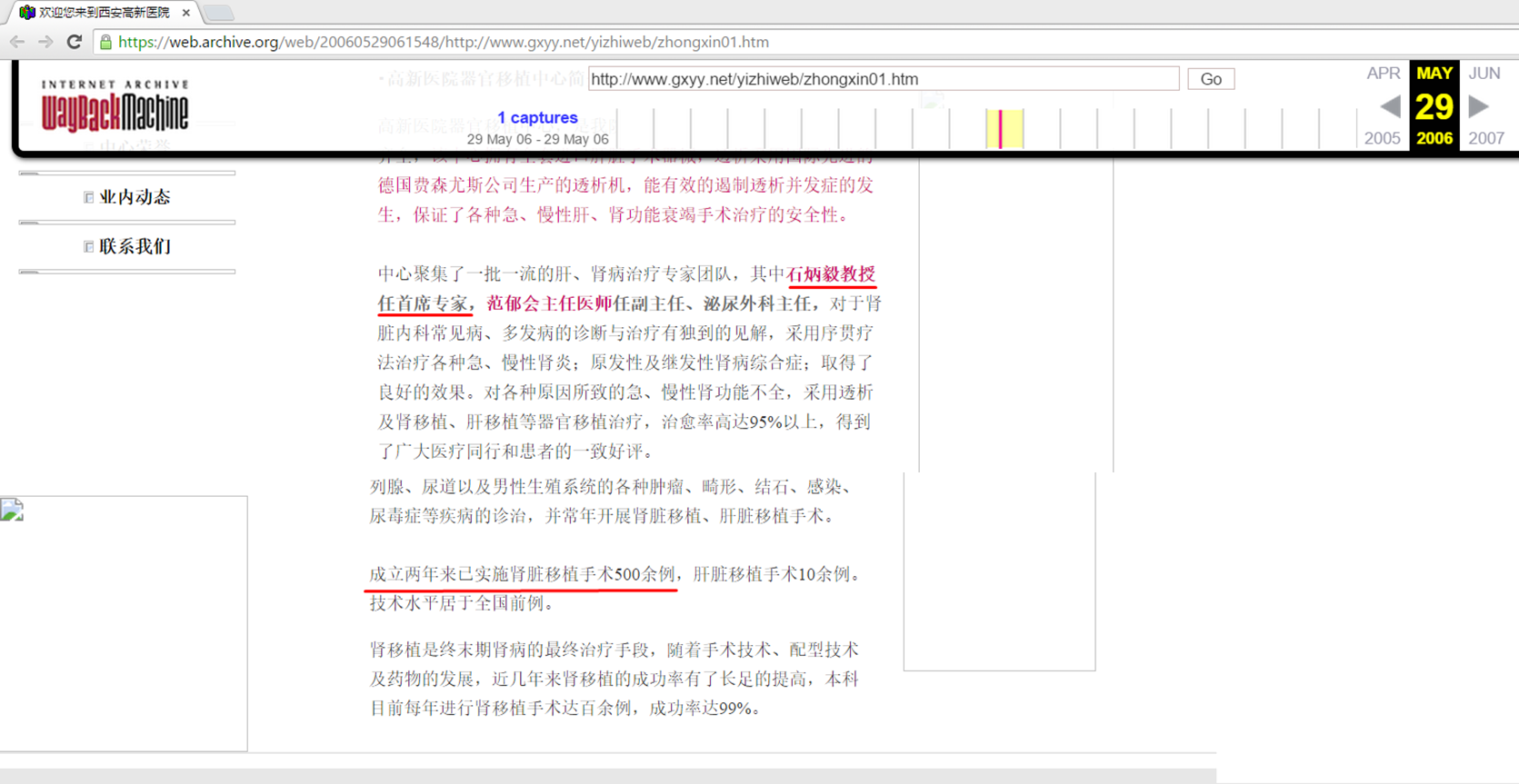
Figure 5.10 Brief Description of Gaoxin Hospital’s Organ Transplant Center
A Phone investigation by the WOIPFG indicated that, Gaoxin Hospital’s claim that in 2007, before the run up to the Beijing Olympic Games, its transplant numbers went down, this was actually a lie, a deception to fool international society.
“Different from the situation in the September 2006 interview, this Wednesday, November 14, 2007, deputy director surnamed Zhang and director Fan of Gaoxin Hospital’s Urology Department both stated that, because of the authorities’ control of the donor supply, they had fewer transplants than last year, but it doesn’t mean that there are fewer donors in the supply pool. Deputy Director Zhang told the reporter that the number of donors would come back to normal after the 2008 Olympic Games.[460]”
Our estimation of the number of transplants performed at this hospital is such that: although the hospital continued to perform transplants until the November 14, 2007 interview, which means it did not stop the transplant practice on May 1 of 2007, our conservative estimate is that the first round of large scale transplants ended in December 2007. In 2011, this hospital again was granted approval by the Ministry of Health. If we estimate that the hospital performs 10 transplants a year (less than this number, the hospital would be disqualified), the total number of transplants should be 1,290 or more (250×5+10×4=1290).
VII. Medium and Small Scale Hospitals also Tamper with Data and Delete Webpages
1. Dongguan Taiping People’s Hospital: It is a township hospital. Before 2007, it had performed more than 3,000 kidney transplants and claimed itself to be ranked No. 2 in China
In 2006, the number of kidney transplants suddenly surged; the hospital provided professional assistance to another hospital during 1,537 cases of kidney transplants. We suspect the donors were provided by the Chinese military.
Gongguan Taiping People’s Hospital is a “Grade 3 Class A” Hospital[461]. It is also a township hospital. The hospital is also known as The First People’s Hospital of Dongguan. It was not accredited to conduct organ transplant due to it not passing the Ministry of Health’s qualification review in 2007. However, it was granted Grade A kidney transplant certificate and Grade B liver transplant certificate by the Guangdong Provincial government in 2004.
The hospital has conducted an exceedingly large number of kidney organ transplants and the circumstances are suspicious:
1) It started to perform kidney transplants after 1996 and the practice continued until 2007. During those 11 years, it performed more than 3,000 kidney transplants, ranked as No. 2 in the entire country in terms of quantity[462].
2) Most transplants were performed after 1999: Between 1997 and December 2003, the hospital conducted 1,100 kidney transplants[463]. Between January 2001 and December 2002, it conducted 605 kidney transplants[464]. In 2003, it performed 360 kidney transplants. Between 2001 and 2005, it conducted 28 liver transplants[465].
3) The year 2006 saw a sharp increase in the numbers of transplants performed, 300 transplants in three months: In 2003, this hospital did 360 kidney transplants; in 2004, 260 cases; in 2005, 160 cases. Whereas in 2006, the hospital personnel worked overtime and had already performed 300 kidney transplants in the first three months[466].
4) On several occasions, the hospital provided medical expertise to assist other hospitals in performing organ transplants: with the support of Taiping People’s Hospital, Kunming Forensic Hospital of Yunnan Province performed 1,537 cases of kidney transplants between 2001 and 2008[467].
5) The hospital has military background: Many doctors are retired professors from Zhujiang Hospital of Guangdong Province (formerly First Medical University of PLA, currently Teaching Hospital of Southern Medical University). These professors sometimes went to Shenzhen Military Police Hospital to perform transplant operations. Director Li Jie of Urology Department worked at Zhujiang Hospital for more than 10 years. He personally participated in over 4,000 kidney transplants before 2010, during 500+ of these transplants he acted as the chief surgeon. He participated in more than 50 liver transplants, among which he participated in 12 operations as the chief surgeon[468].
6) This hospital launched an overwhelming amount of ads in Southeast Asia, claiming that the waiting time for a transplant is extremely short. Min Sheng Bao, a Taiwan-based newspaper, reported on January 9, 2004, “Taiwan Kidney Transplant Tour Group organizes a tour group to mainland China every month” and that “Dongguan Taiping People’s Hospitals is one of such hospitals; it is well-known for kidney transplants.”
7) The number of transplants performed in Dongguan city is even bigger.“As early as 2007, the main hospitals performing organ transplants in Dongguan include Dongguan People’s Hospital, Dongguan Taiping People’s Hospital and Donghua Hospital.” According to the person in charge at the Medical Affairs Section of Dongguan Health Bureau, Taiping People’s Hospital and Dongguan People’s hospital are both very outstanding in terms of kidney transplants.[469]”
2. Kunming Forensic Hospital: Not only performs forensic analysis, but also performs organ transplants. The source of the organs remains a mystery
Kunming Forensic Hospital is the earliest and largest forensic hospital that provides services including forensic sciences, emergency treatment for trauma victims, as well as monitoring and treatment of special groups[470]. This hospital did not pass the qualification review of the Ministry of Health in 2007.
Kunming Forensic Hospital has Department of Surgery and a Kidney Dialysis Center[471].
Between 2001 and 2008, Kunming Forensic Hospital conducted several thousand cases of tissue matching for organ transplant purpose, and accumulated rich clinic experience for conducting organ transplant[472]. As of April 2008, with support from the Blood Purification and Organ Transplant Center at Dongguan Taiping People’s Hospital, Kunming Forensic Hospital performed 1,537 cases of kidney transplants[473].
The General Hospital of Lanzhou Military Region is a “Grade 3 Class A hospital”[474]. On Aug. 1, 2013, it was authorized by National Health and Family Planning Commission to transplant kidneys[475]. According to the hospital, from January 2004 to January 2010, 396 cases of kidney transplant were performed[476]. The average number was 66 cases per year, and this hospital started kidney transplants no later than April 2001[477]. Our adjustment is as follows: From April 2001 to December 2003 (not reported), 181 (66 x 2.75) transplant cases would have been completed. From February 2010 to December 2014, 324 cases of kidney transplants would have been performed. Thus The General Hospital of Lanzhou Military Region could have performed a total of 901 kidney transplant cases in the time period between April 2001 and December 2014.
VIII. Data Processing Methods for Other Hospitals
Our main data processing methods are filling in the missing and non-updated webpage data, querying the archived websites and confirming whether the data has been tampered with. For some of hospitals where no sufficient transplant data was found, we made adjustments according to the following principles:
1.Reported data and data published in medical papers covered only some of the time periods.
We filled in missing transplant data based on the hospitals’ average numbers of transplant cases reported in the past. Out of the 164 hospitals designated by the Ministry of Health to transplant organs, many didn’t report any transplant numbers, or their numbers were much smaller than the Ministry of Health’s standard number set for these designated hospitals.
2.Many hospitals designated by the Ministry of Health to transplant organs didn’t report any transplant numbers or their numbers were much smaller than the Ministry of Health’s standard number set for these designated hospitals. We adjusted their data according to the minimum standard set by the Ministry of Health.
This presents an investigative quandary. 164 hospitals is not a small number; any assumptions that we make on these hospitals average transplants per year will have a significant effect on our overall estimate of transplants over time. It is the path of least resistance to accept the hospitals reported numbers. After all, we are not the Ministry of Health; we are fully aware that here are many minimum bureaucratic specifications which are not met in China with no consequence whatsoever. And some hospitals may be telling the truth. In fact, some hospitals have been known to exaggerate their actual harvesting capabilities both as a sales technique and because “over-fulfilling-the-quota” is such an integral part of CCP culture. However, we cannot deny the overwhelming evidence of our investigative experience, and the pattern which has been reflected throughout this chapter: since 2006 the vast majority of China’s hospitals have worked very hard to diminish the perception of how many transplants are carried out annually. Therefore we chose a compromise estimate: we adjusted the 164 hospitals data according to the minimum standard set by the Ministry of Health.
According to “The Ministry of Health’s Notification regarding Liver, Kidney, Heart and Lung Transplantation Practice Management” (Methodist Medical [2006] No. 243): A [designated] medical institute shall complete no less than 20 cases of liver transplant per year; for transplants performed for benign end-stage liver diseases, the one-year survival rate shall not be lower than 80 percent, the three-year survival rate not lower than 70 percent, the five-year survival rate not lower than 60 percent. For transplants performed for liver cancer, the one-year survival rate of transplanted liver shall not be lower than 70 percent, the three-year survival rate not lower than 50 percent. A medical institute shall complete not less than 30 cases of kidney transplant per year. The one-year survival rate of transplanted kidneys shall not be lower than 85 percent, the three-year survival rate not lower than 70 percent, the five-year survival rate not lower than 60 percent. Training Bases: no less than 100 cases of kidney transplant annually in the recent three years; no less than 50 cases of liver transplant per year in the recent three years[478]. According to a China News Service (CNS) report on Aug. 18, 2007, 164 hospitals had been examined and approved by the Health Ministry to carry out organ transplants in mainland China up to August 2007[479].

Figure 5.11 Web cache of The Ministry of Health’s Notification regarding Liver, Kidney, Heart and Lung Transplantation Practice Management
Datong Third People’s Hospital is a “Grade 3 Class A hospital”[480]. It was designated by the Ministry of Health to transplant kidneys on May 23, 2007[481]. The data published by this hospital shows that over 40 cases of allogeneic kidney transplant were conducted from 1998 to May 2011[482],[483], which is far below the criteria set by the Ministry of Health. From 2000 to the end of 2014, this hospital should have completed 450 cases of kidney transplant according to the 30-cases-per-year standard set by the Ministry of Health.
In 1995, the Ministry of Health named the First Affiliated Hospital of Fujian Medical University as one of the first batch of“Class A Grade 3hospitals” in Fujian Province[484]. On May 23, 2007, it was designated by the Ministry of Health to transplant livers[485]. The hospital’s Hepatobiliary Surgery Department set up a liver transplant technological system specifically targeting patients, who suffer from end-stage liver diseases. Wu Mengchao was the honorary director of the hospital’s liver transplant center[486]. The center began surgeries not later than January 2001[487]. Yet there is no data reported by them. From January 2001 to December 2014, this hospital would have completed a total of 280 cases of liver transplants, according to the 20-cases-per- year standard set by the Ministry of Health.

Figure 5.12 Web cache of the First Affiliated Hospital of Fujian Medical University
3. A number of cardiac death organ donation transplant pilot hospitals designated by the Ministry of Health didn’t report their transplant data, or their numbers are much lower than the Ministry of Health standard. We adjusted them according to the minimum standard set by the Ministry of Health.
The Ministry of Health Notification on commencing cardiac death organ donation transplant pilot sites[488].Grade 3 Class A hospitals that meet the requirement of “The Ministry of Health notification regarding liver, kidney, heart, lung transplantation practice management” (Methodist Medical [2006] No. 243) are qualified to apply for being cardiac-death organ donation transplant pilot sites. Since May 1, 2007, these hospitals haven’t conducted illegal organ transplants[489].Our data correction for these hospitals ends in April 2007.
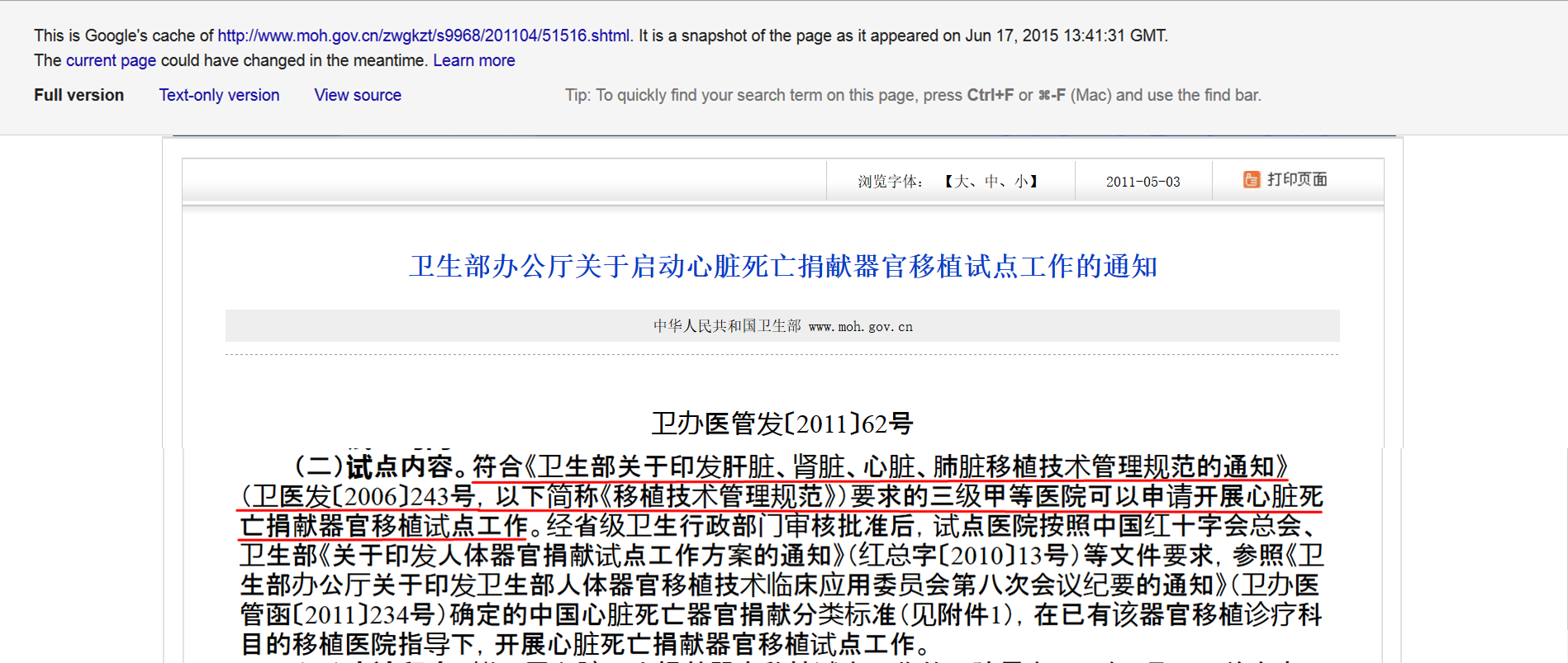
Figure 5.13 Web cache of The announcement from the General Office of the Ministry of Health on starting up the pilot organ transplantation project with organs donated after cardiac death
The Second Hospital of Hebei Medical University is Hebei Province’s cardiac-death donor liver transplantation pilot hospital[490]. On Sept. 28, 2001, the first case of liver transplant in Hebei Province is performed in this hospital[491]. Liver transplant: 20 cases per year. From 2002 to April 2007, the hospital completed 106 cases of liver transplant.
4. Grade 3 Class A Hospitals can transplant organs. We use the minimum five cases per year of organ (usually kidney) transplants to amend the data.
According to the criteria to be a Grade 3 Class A hospital, in addition to facilities and staffing requirements, completing“the minimum five cases per year of organ transplant” is a must[492].
The PLA No. 94 Hospital belongs to the first batch of Grade 3 Class A hospitals in China[493]. It failed the Ministry of Health qualification examination in 2007. It has established a kidney transplant urology clinic[494].
The clinic operated the first case of kidney transplant in 1998[495]. From 2000 to December 2006, it completed a total of 35 cases of kidney transplant.
5. A number of hospitals that passed the Organ Transplant Quality Assessment performed by the Guangdong Provincial Medical Association report their data far below the access standard. We adjust according to the minimum standard of Guangdong Provincial Medical Technology Projects.
From September to December 2003, the Organ Transplant Quality Evaluation Panel, Guangdong Provincial Medical Association assessed 36 hospitals that declared kidney, liver or heart transplant, with both written and site assessment[496]. Its minimum standard of the Medical Technology Projects for liver transplant is successful completion of more than 10 cases per year[497]. Such standard for Kidney transplant is successful completion of more than 50 cases per year and the one-year survival rate must be higher than 90 percent[498].
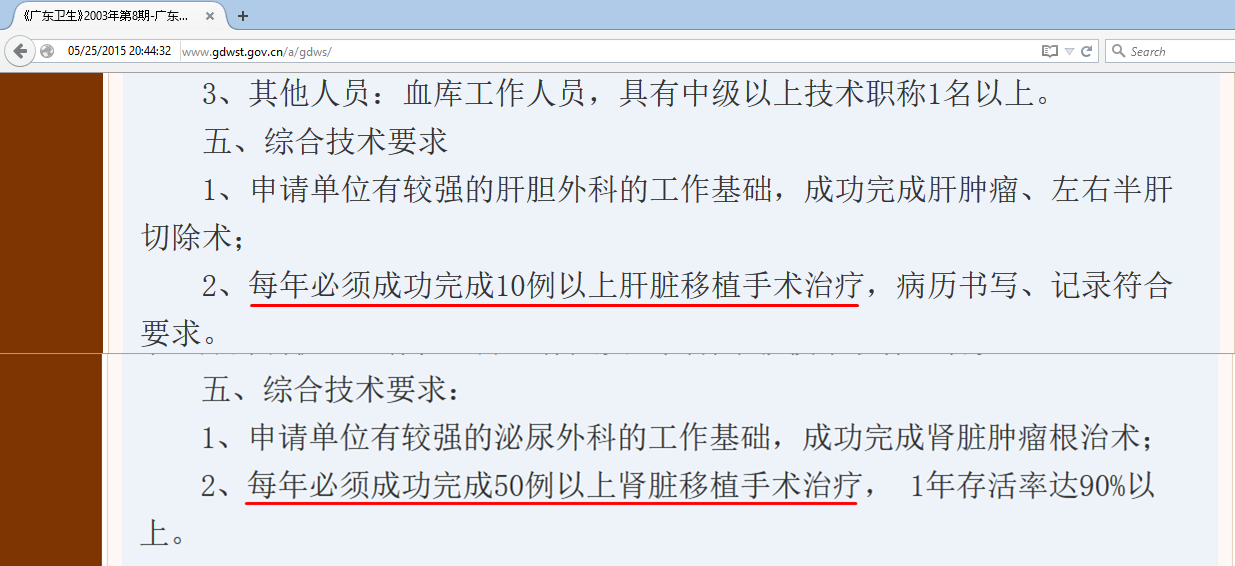
Figure 5.14 Web cache of No.67 Notice of issuance heart transplantation and other medical technology projects access standards by Guangdong Health

Figure 5.15 Web cache of Quality evaluations on the hospitals kidney, liver and heart transplantation by Guangdong Medical Association
Guangdong Clifford Hospital (Guangzhou University of Chinese Medicine Clifford Hospital)
Guangdong Clifford Hospital is a Grade 3 Class A hospital[499]. It failed the Ministry of Health qualification check in 2007. However, the hospital obtained Guangdong Province Class A kidney transplant qualification in 2004. Kidney transplant: October 2002–March 2005, the hospital completed 146 cases of cadaveric kidney transplants[500].
We calculated conservatively that with the minimum standard of 50 cases of kidney transplants per year, from 2002 to May 1, 2007, this hospital completed more than 270 cases.
6. The statistics and analysis of the amended transplant data for 712 hospitals further proves that almost all CCP hospitals conceal and tamper with transplant data.
After data adjustment in accordance with the above methods, we calculated liver and kidney transplant data for these 712 hospitals. Very conservatively calculated data are as following: 308,981 cases of kidney transplants annually, 92,194 cases of liver transplants annually. Since 2000, the number of transplant is 24,800 cases per year, which is almost three times the data released by the Ministry of Health.
The statistic of different ways of correcting liver kidney transplant data for 712 hospitals is shown below. As we can see, we have to amend data except for only 16 percent of kidney transplant hospitals and 21.5 percent of liver transplant hospitals. It is shocking to see to what serious extent the CCP hospitals are tampering with and concealing data.
Table 5.8: Correction of liver kidney transplant data for 712 hospitals:
|
Data Classification/Processing Method |
Kidney Transplant |
Liver Transplant |
Total |
|
Hospitals designated by the Ministry of Health that have tamperedwith data, deleted or stopped updating webpages: We modifiedthe data individually. |
49 |
33 |
82 |
|
Filling up the gap for time periods according to the Ministry of Health’s minimum entry standards |
22 |
30 |
52 |
|
Hospitals designated by the Ministry of Health: filling up the gap for time periods according to the available information |
46 |
21 |
67 |
|
Guangdong hospitals designated by the Ministry of Health: filling up the gap for time periods according to the Guangdong Provincial standard |
1 |
|
1 |
|
Hospitals designated by the Ministry of Health, data not adjusted |
23 |
21 |
44 |
|
Filling up the gap for time periods according to the Ministry of Health DCD standards |
46 |
61 |
107 |
|
Hospitals designated by the Ministry of Health, non-designated projects: We count as one transplant case per year. |
3 |
9 |
12 |
|
Hospitals not designated by the Ministry of Health that tamper with data, delete or do not update their webpages |
8 |
|
8 |
|
Hospitals not designated by the Ministry of Health: filling up the gap for time periods according to the Guangdong Provincial standard |
11 |
2 |
13 |
|
Grade 3 Class A hospitals not designated by the Ministry of Health: filling up the gap for time periods based on existing information. |
52 |
15 |
67 |
|
Grade 3 Class A Hospitals not designated by the Ministry of Health, data not adjusted |
80 |
49 |
129 |
|
Grade 3 Class A Hospitals:We put five cases per year for each. |
142 |
12 |
156 |
|
Grade 3 Class A Hospitals not designated by the Ministry of Health: We put one case per year. |
5 |
32 |
37 |
|
Grade 1 & 2 hospitals not designated by the Ministry of Health:filling up the gapfor time periods with available information |
22 |
1 |
23 |
|
Grade 1 & 2 hospitals, no amendment |
57 |
16 |
73 |
|
Grade 1 & 2 hospitals, data not reported: We countedone case per year. |
80 |
24 |
104 |
|
Total |
647 |
326 |
|
Moreover, the non-adjusted data, which are disclosed by a small proportion of hospitals, are not demonstrated to be announced on time or accurate. First of all, the Ministry of Health has never released an actual number of organ transplants for each hospital. What it gives is a severely diminished total number. This fact by itself shows that the CCP’s Ministry of Health has been consistently deceiving the international community. An analysis of the motivation for the CCP’s hospitals to have been systematically concealing and tampering with transplant data reveals a top-down pattern of deception.
Take those hospitals designated by the Ministry of Health as examples. According to our investigation, there are a total of 190 kidney transplant hospitals and 175 liver transplant hospitals (including organ transplant hospitals, DCD hospitals). Among them, only 23 kidney transplant hospitals and 21 liver transplant hospitals report data we didn’t have to adjust. The proportion is only 12 percent respectively. Again among these 12 percent of hospitals, only three hospitals (Affiliated Hospital of Qingdao University, First Affiliated Hospital of Henan Chinese Medicine College and First Affiliated Hospital of Xi’an Jiaotong University) have reported their kidney transplant data since 2014, accounting for only 1.6 percent of the Ministry of Health’s designated hospitals.
For other hospitals, which have non-designated organ transplant projects, the main reason we didn’t adjust their data is we don’t know how to. Since 2006, the CCP has deleted and tampered with data on a large scale. It has been extremely difficult to find any data either online or in published articles. To be conservative, we have to use the very limited data published by these hospitals themselves.
For instance, the Navy General Hospital is designated by the Ministry of Health for liver transplants. It also works on non-designated kidney transplant projects. Although our previous analysis demonstrates the amount of liver transplant performed in this hospital reaches the thousands, supposedly its number of kidney transplants should be large, too. However, according to the Navy General Hospital’s claim, it is one of the earliest hospitals in Beijing to develop kidney transplantation technology and has been operating hundreds of kidney transplant surgeries[501]. We assumed 300 cases of kidney transplants for this hospital.
Also, the famous Sino-Japanese Friendship Hospital in Beijing claimed it has performed more than 10 cases of living related liver transplantation and cadaveric liver transplantation, although Huang Jiefu provides guidance there personally, and the hospital is fully equipped for all kinds of liver transplant surgeries and intensive care. It is a comprehensive hospital with strong liver transplant capabilities[502]. We assumed 11 cases of liver transplants for this hospital.
Let’s take the example of the PLA No. 309 Hospital. In the March 2015 special health issue of “The CPPCC News,” Shi Bingyi revealed, “Since 1999, we have completed more than 800 cases of liver transplants[503].” Conservatively, we put only 800 cases for this hospital. Of course, in the following analysis, we will show that the amount of its kidney transplants per year is much closer to 3,000.
IX. Actual Transplant Volume Likely Even Greater Than 401,678
To ensure authenticity of the data, we have expended every effort to remain conservative in our deductions. Therefore, it’s very likely that the actual numbers of organ transplants performed by these hospitals far exceed 401,678.
The Ministry of Health has never officially released the actual number of organ transplants for each hospital. What it has provided is a severely diminished total number. The 712 hospitals account for only 13% of total hospitals in China, and the total excludes military hospitals and Chinese medicine hospitals.
1.For some hospitals reported in the investigative leads from Minghui.org, these hospitals’ information related to transplant surgeries were all deleted. Therefore, the number of their transplant cases is not included in the total.
Investigative lead: The Second Affiliated Hospital of Jilin University and Armed Police Hospital in Changchun work overtime to do kidney transplants.
Doctor Gu of the Second Affiliated Hospital of Jilin University in Changchun City oversees kidney transplants. He was initially responsible for doing kidney transplants. The hospital director changes every two years, but the deputy director has remained in the same position for years. After the deputy director left, Doctor Gu became the deputy director. Prior to 2005, whenever the hospital did a kidney transplant, they would openly ask the patient's family to pay 10,000 yuan for travel expenses. The organ matching only took three to five days, and the patient could do a kidney transplant right away. When the hospital was busy, they could do two to three cases a day, sometimes six to seven surgeries a week. The hospital did at least more than 10 cases of kidney transplant surgeries each month.
The Armed Police Hospital is also working overtime to do kidney transplant surgeries. Where do so many kidneys come from[504]?
2. The number of transplants performed by several hundred hospitals is not included in the total number.
The number of liver and kidney transplant cases done by a total of 712 hospitals is not included in the total number. Ye Qifa, the executive chairman of China Organ Procurement Alliance said that since the “Human Organ Transplant Ordinance” was introduced in 2007, the number of medical institutions that officially perform transplant operations was reduced from over 1,000 to over 160[505]. Therefore, the number of transplant surgeries done by several hundred hospitals is not included in the total number.

Figure 5.16 Web cache of (Apr. 25, 2015) People’s Daily, Hubei Channel
3. For many Grade 3 Class A hospitals and hospitals of lower grades that can carry out transplants, we did not estimate the numbers of transplants and only counted as one case in the total number.
For 100 hospitals that can carry out kidney transplants, we did not estimate a number of transplants and counted only one case in the total number for years 2000 to 2014. We did the same for 76 hospitals for liver transplants.
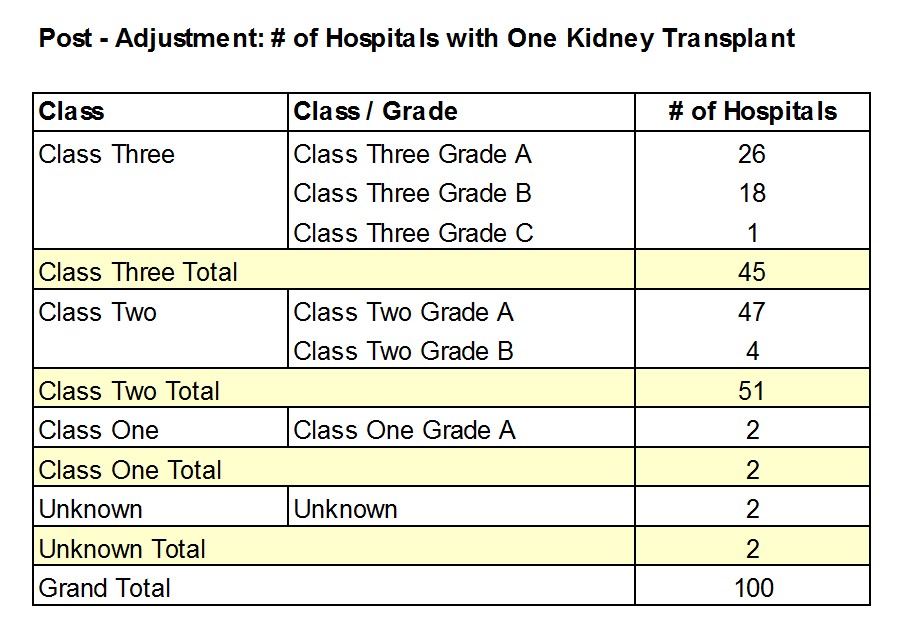
Table 5.9 Number of hospitals with one kidney transplant (post-adjustment)

Table 5.10 Number of hospitals with one liver transplant (post-adjustment)
The First Affiliated Hospital of Fujian Medical University, Fujian Province, was one of first batch of Grade 3 Class A hospitals named by the Ministry of Health in Fujian Province[506].In April 2002, the hospital implemented one case of kidney transplantation[507]. Therefore, one case is included in the total number.
Xinxiang Second People’s Hospital is a modern comprehensive Grade 3 hospital[508]. The hospital did not pass the qualification examination by the Ministry of Health in 2007. The Department of Urology of Xinxiang Second People’s Hospital is very strong in kidney transplantation. It has close ties to many transplant centers in the nation and shared kidney allocation resources[509]. One case is included in our total number.
4. For hospitals reported by witnesses, the number of transplants is difficult to estimate.
The Shandong Police General Hospital is a Grade 2, Class A hospital. The hospital has a strong technical force, especially in kidney transplant. They have many experts leading the field[510]. A senior employee who had worked in the healthcare system in Jinan City of Shandong Province for more than 20 years disclosed that many live organ transplants were carried out by Qianfoshan Hospital of Shandong Province, Shandong Police General Hospital, Shandong Provincial Prison and Shandong Provincial Women’s Prison and many prisons and forced labor camps in collusion. (These hospitals are all located on the Southern Industrial Road. The women’s prison is located in the southwest corner of the men’s prison. Their name board on the street reads "Shandong Province Industrial Development Co., Ltd.") They form a "big assembly line" operation, which includes the arrangement of personnel to exchange organs, the removal of live organs, organ transplantation, and the allocation of costs, etc[511]. Due to layers of information blockade, the outside world cannot know the exact number of live organ transplants carried out by this hospital.
From 2001 to 2003, Liaoning Provincial Thrombosis Hospital of Integrated Chinese and Western Medicine detained approximately 6,000 Falun Gong practitioners, harvested live organs from more than 4,000 people and threw their bodies into the "crematory furnace" at the hospital backyard after organ removal[512]. After the removal of live organs from more than 4,000 people, where did the organs go? The outside world cannot know, nor can we.
5. We cannot estimate the number of living individuals exported for their organs.
In 2006, a veteran military doctor in Shenyang disclosed: “There is a large number of live human exports in China’s export products, namely the Chinese domestic forces collude with foreign forces and export living people overseas in the form of goods and use their organs for organ transplants overseas. China has specialized agencies that handle the dead bodies after the organs are removed. Many overseas Chinese embassies and consulates are involved. Based on what I know, in 2005, the number of exported living humans is more than 940.[513]”
For the past 16 years, we cannot quantify how many fresh organs or living people are exported.
6. The number of transplants that are completed by hospitals under the guidance of large transplant centers is not included in the total number of transplant cases.
As of April 15, 2015, the First Affiliated Hospital of Xi’an Jiaotong University implemented a total of 4,023 cases of kidney transplants[514].
As of December 2012, the First Hospital of Xi’an Jiaotong University directed 23 hospitals from 13 provinces and cities to perform more than 10,000 cases of kidney transplantation[515].

Figure 5.17 Web cache of First Affiliated Hospital of Xi’an Jiaotong University
Our report listed only 4,023 cases because we cannot verify the exact location of the kidney transplants or which hospital implemented the transplant surgeries and the time of the surgeries.
Please refer to the next chapter for what we believe is a more realistic number of victims of organ harvesting, based on our estimate of 401,678 transplants from official hospital data.
References:
[341]https://www.hqms.org.cn/usp/roster/index.jsp, accessed on July 19, 2015.
[342] David Matas “Numbers,” in State Organs: Transplant Abuse in China (published in 2012)
[343]A Bright but Arduous Path August 25,2004
From Minghui website:http://www.clearwisdom.net/emh/articles/2004/9/26/52823.html
[344]Gutmann, Ethan (2014-08-12). The Slaughter: Mass Killings, Organ Harvesting, and China's Secret Solution to Its Dissident Problem (Ch. 1). Prometheus Books.
[345]Hospital Introduction of “Southern Hospital affiliated with Southern Medical University”.
[346]from “People's Republic of China National Health and Family Planning Website”, in the attachment titled “Notice from Office of the Ministry of Health on better registration of medical organ transplant”, item 1 titled “ The first batch of hospital list that approved by the Ministry of Health Human Organ Transplant Clinical Application Committee”.
[347]Hospital Introduction of “Southern Hospital affiliated with Southern Medical University”.
[348]From the “Official website of Southern Hospital affiliated with Southern Medical University” Renal Transplantation Introduction, dated July 16, 2009
[349]”Nafang website” Aug, 2003 report titled “Guangdong Province, average daily three cases of kidney transplant, count at one fifth of total case number nationwide.” Written by Yangcheng Evening News reporter Zhang Xiaolei and intern Ma Zewang.
[350]“Journal of Hepatobiliary Surger” 2012 volume 20 period 6, page 425-427, titled “Diagnosis and treatment of adult biliary complications after liver transplantation, authors: Li Xianghong; Luo Zhengchao; Lin Jianhua; Cui Zhongling; Zhou Jie (Hepatobiliary Surgery department of Southern Hospital affiliated with Southern Medical University)
[351]”WOIPFG” titled “Investigation Report on mainland Chinese over the live organ harvesting of Falun Gong practitioners”, original report published on April 16th, 2006, revised report published on April 22 and May 1, 2006.
[352]“JOURNAL OF SOUTHERN MEDICAL UNIVERSITY” 2006, volume 26 period 5 page 651-653, titled “MR evaluation of long-term complications after liver transplantation”, author Jiang Zhiqiang; Xu Yikai (Southern Medical University affiliated Southern Hospital Imaging Center, Guangdong City, Guangzhou province)
[353]Hospital Introduction of “ShanghaiChanghaiHospital “
[354]People's Republic of China National Health and Family Planning Website, titled “List of hospitals that are approved to carry out human organ transplant”, dated Aug 1st, 2013.
[355]Dr. Aliang from SecondMilitaryMedicalUniversity in Shanghai affiliated ChanghaiHospital
[356]Minghui.org article titled “Transplant Doctor's Suicide is another Piece of Evidence Pointing to the Crime of Live Organ Harvesting”, author Zhong Yan, dated May 30th, 2007
http://www.clearwisdom.net/emh/articles/2007/5/30/86261.html
[357]” Changhai Hospital Urology Department ” Kidney transplant
[358]“CHINESE JOURNAL OF ORGAN TRANSPLANTATION” 2006 volume 27 period 6 page 374-375, titled “Renal artery stenosis diagnosis and treatment (five samples attached)”, author Yang Qing; Su Ming; Wang Linhui; Sun yinghao; Yang Bo; Ni Weiping (Changhai Hospital, Second Military Medical University Urology department”)
[359]Hospital Overview of “ThirdMilitaryMedicalUniversity affiliated XinqiaoHospital”.
[360]from “People's Republic of China National Health and Family Planning Website”, in the attachment titled “Notice from Office of the Ministry of Health on better registration of medical organ transplant”, item 1 titled “ The first batch of hospital list that approved by the Ministry of Health Human Organ Transplant Clinical Application Committee”.
[361]“ThirdMilitaryMedicalUniversity affiliated Xinqiao Hospital Hepatobiliary Surgery website” Department Introduction
[362]“ThirdMilitaryMedicalUniversity affiliated Xinqiao Hospital Hepatobiliary Surgery website” article titled “The power of Science”; author Liang Ping
[363]’Minghui.org” article titled” Investigation Leads: The Army Kidney Disease Center Surgical Division Once Performed 24 Kidney Transplants in One Day”.
[364]“Chong Qing Medical Journey” 2007 volume 36 period 24 page 2535-2537, titled “Clinical analysis of 3102 cases of second cadaveric renal transplantation”, author Zhang Yingpu; Huang Chibing; Wang Pingxian; Fan Mingqi; Feng Jiayu; Xiao Ya; Fang Zhengqiang; Jia Weisheng (Third Military Medical University affiliated Xinqiao Hospital Urology Department, Chongqing)
[365]“ThirdMilitaryMedicalUniversity affiliated Xinqiao Hospital Second Urology Department website” Medical backbone Zhang Yingpu
[366]“Chinese Hospital Journey” 2011, period 3, article titled “Interview with Wang Weidong, President of Third Military Medical University affiliated XinqiaoHospital”, dated Feb 28th, 2011
[367]“Xinhua News website”, article titled “Three Necessary conditions to complete the organ transplants” dated July 24th, 2012. Source from Xinhua news Chongqing channel
[368]“Xinhua New Chongqing Channle” article titled”Chongqing start of human organ donation; Preliminary finalized eight hospitals”, dated July 24th, 2012.
[369]” Interactive Encyclopedia”, People's Liberation Army 175 Hospital
[370]“Baidu Encyclopedia” Introduction to 175 Hospital
[371]“People's Liberation Army 175 Hospital” Introduction
[372]Hospital Introduction to “People's Liberation Army 175 Hospital”
[373]from “People's Republic of China National Health and Family Planning Website”, in the attachment titled “Notice from Office of the Ministry of Health on better registration of medical organ transplant”, item 1 titled “ The first batch of hospital list that approved by the Ministry of Health Human Organ Transplant Clinical Application Committee”.
[374]“People's Liberation Army 181 Hospital” Department introduction for Amy kidney transplant and dialysis center
[375]Google search: “Since successfully carried out a kidney transplant in 1986, it has now been accumulated more than 2000 cases”.
[376]“People's Liberation Army 181 Hospital” Hepatobiliary and pancreatic surgery department introduction
[377]“Baidu Encyclopedia” People's Liberation Army 452 Hospital
[378]from “People's Republic of China National Health and Family Planning Website”, in the attachment titled “Notice from Office of the Ministry of Health on better registration of medical organ transplant”, item 1 titled “ The first batch of hospital list that approved by the Ministry of Health Human Organ Transplant Clinical Application Committee”.
[379]“Sichuan Medical Journey” 2002 volume 23 period 7 page 711-712, article titled” Treatment for Severe leukopenia after Kidney transplantation”, author Xu Yahong; Xiao xinming; Gu Weixin; Ma xiaoping; Hu xiaochun (People's Liberation Army 452 Hospital, Chengdu City, Sichuan Province)
[380]“wang yi website” article titled “Relying on the market to protect the "battlefield " – Interview with president Zhang Cong of People's Liberation Army 452 Hospital”. Source from Xinhua News
[381]minghui.org article titled” Recording: military hospital bluntly admit using Falun Gong practitioners’ liver for transplant”; dated May 2nd 2006.
[382]Minghui.org article titled” Investigation lead: Shengyang city government suspected involved in illegal live organ transplants”.
[383]“GUIDE OF CHINA MEDICINE” 2010 volume 8 period 28 page 54-55, article titled “Patients’ Cyclosporine A blood concentration monitoring results analysis after Kidney transplant”, author Guo Jiangning; tang Hongyun; Ning Bo; Zhang Wujie.
[384]Hospital introduction for TianjinFirstCentralHospital
[385]from “People's Republic of China National Health and Family Planning Website”, in the attachment titled “Notice from Office of the Ministry of Health on better registration of medical organ transplant”, item 1 titled “ The first batch of hospital list that approved by the Ministry of Health Human Organ Transplant Clinical Application Committee”.
[386]Hospital introduction for TianjinFirstCentralHospital
[387]from “Chinese Organ Transplantation Network” website, introduction for “Hospital introduction for Tianjin First Central Hospital Organ transplantation center”, dated June 11th, 2010
[388]TianjinFirstCentralHospital, Eastern Organ transplantation center introduction
[389]Yanhuang World Magazine Sina official blog, “Bringing out the team that Climbing the pinnacle of the world's medical” author Shen Yongyang, posted on Sept 17th, 2010.
[390]from “Chinese Organ Transplantation Network” website, “The reason why our website recommend Armed Police General Hospital Institute for Organ Transplantation”, dated Jan 14th, 2011.
[391]Renmin network website(Tianjin)introduced(November 15, 2010): SHEN Zhongyang, the President of Tianjin First Center Hospital, won the “ Wu Yang Award”, and became the unique expert of organ transplant medicine in the Award which is the nonofficial award of the highest level, the most authoritative award on science and technology of Medicine and Health in China.
[392]Guang Ming Daily website (January 27, 2011) introduced: SHEN Zhongyang: the hope of transplant makes a life become stronger.
[393]Baidu Xushu website reproduced the website of Zhonghua hun(soul ofZhonghua) (2013): Zhi Long, Rui Xing. Making a life stronger, reported SHEN Zhongyang, the famous expert of organ transplant medicine, the President of Tianjin First Center Hospital, Zhonghua hun(soul ofZhonghua) website, 2013.
[394]The Chinese technology market news paper (cnki.net ) website reported(January 6, 2015): Enlarging the hope of a life by organ transplant, reported SHEN Zhongyang, the expert of liver transplant in Tianjin city and his teams.
[395]Tianjin First Center Hospital website reported(January 9, 2015): Enlarging the hope of a life by organ transplant.
[396]Wu Hongyue, Luo Caoshu, Li Ying, Feng Guowu . The pioneer in advance promote the legislation of voluntary organ donation, reported the professor SHEN Zhongyang, the President of Tianjin First Center Hospital (3), Science and Technology Daily website, December 10, 2014.
[397]Jinwan Media Group introduced(January 6, 2015): Enlarging the hope of a life by organ transplantion, reported SHEN Zhongyang, the expert of liver transplant in Tianjin city and his teams.
[398]ZHANG Guodong. The Endoscopy DiagnosisandTreatment of biliary complicationsperformed liver transplantation [C].The proceeding of Digestive Disease Symposium, the 7th National Conference of Chinese Medical Association. May 5th, 2007.
[399]CHEN Litian, SHEN Zhongyang, ZHU Zhijun, ZHENG Hong, DENG Yonglin, PAN Cheng, ZANG Yunjin. Analysis of being noted problems related with rapid performing extraction of livers from donors [J]. Tianjin Medical Journal. 2009, 37(09):793~794.
[400]Netease news website reproduced China liver and kidney transplantation website to report(March 27th, 2006) : China became the newly-merging center of organ transplantation in the world, has the center “rich” organs source?
[401]Netease news website reproduced China liver and kidney transplantation website (March 27th, 2006) to report: China became the newly-merging center of organ transplantation in the world. Does the center have “rich” organs source?
[402]Northern website (or Enoth.com) (update : November 29th, 2004) reported: “Hepatitis B was Conquered”, therefore, Tianjin First Center Hospital was became the biggest global center of liver transplantation.
[403]The profile of Organ Transplantation Center of TianjinFirstCenterHospital.
[404]LIU Guangming, ZHOU Wenhui, XU Ziqiang, MA Qingtong, LIU Qian, YAO Shijie, BAI Zhijie, WU Jianhui, WANG Haifeng. The diagnosis and treatment of 24 cases of urinary tract tumor performed kidney transplantation in Tianjin First hospital (Zip code: 300192) [J]. Chinese Journal of Organ Transplantation, 2013, 34(02): 124-125.
[405]the overview of TianjinFirstCenterHospital
[406]The overview of TianjinFirstCenterHospital
[407]Chinese Organ Transplantation Network (transplant-china.com) website (October 10, 2008) reproduced Tianjin Daily to report: Events of the Oriental Organ Transplantation Center & Organ Transplant Research Institute.
[408]The Oriental Organ Transplantation Center website reported (January 5th, 2006): The Annual Summary of the Center in 2005.
[409]Tianjin First Center Hospital website introduced: Oriental Organ Transplantation Cneter
[410]Beijing Caoyang Hospital website introduced: the Profile of the Department of Urinary Surgery.
[411]Family doctor online website introduced; the Department of Urinary Surgery in BeijingCaoyangHospital.
[412]Family doctor online website introduced; the Department of Urinary Surgery in BeijingCaoyangHospital.
[413]RenminNetwork website reported (August 25th, 2000): The survival rate from performing over 1000 cases of kidney transplantation reached the international standards in BeijingCaoyangHospital.
[414]HAN Xiuwu, BO Yuhong, GUAN Delin, WANG Jianwen, LI Xiaobei, ZHANG Yong, HAN Zhiyou ( staff members of affiliated Beijing Caoyang Hospital of Capital Medical University). 6 cases of complex bacterial blood infection from the patients performed organ transplantation [J]. Chinese Journal of Infection and Chemotherapy, 2001, 01(02): 106-107.
[415]Affiliated Beijing Caoyang Hospital of Capital Medical University website introduced: the Department of Urinary Surgery.
[416]Affiliated Beijing Caoyang Hospital of Capital Medical University website introduced: the profile of Department of Hepatobiliary Surgery.
[417]Affiliated Beijing Caoyang Hospital of Capital Medical University website introduced: the profile of Department of Hepatobiliary Surgery.
[418]QIN Jianmin, HE Qiang, CHEN Dazhi, LAO Xuejun, LANG Ren, WU Tianming, FAN Hua, LI Peng, HAN Dongdong. Reasons of liver retransplantation, and choices of surgical timing [J]. Chinese Journal of General Surgery, 2006. 21(01): 4-6.
[419]ZHAO Xin, WANG Mingfeng, JIN Zhongkui, HAN Hua, LI Xianliang, WU Tianming, HE Qiang, CHENG Dazhi (both of staff members of Department of Hepatopancreatobiliary and Spleen Surgery of affiliated Beijing Caoyang Hospital of Capital Medical University and of Department of liver transplantation of Beijing Organ Transplantation Center(zip code 100020 )). The treatment and prognosis of early artery complications of performed liver transplantation [J], Chinese Journal of Hepatobilitary Surgery, 2011, 17(11):902-904.
[420]Affiliated Beijing Caoyang Hospital of Capital Medical University website introduced: The profile of Department of Hepatobilitary Surgery.
[421]Affiliated Beijing Caoyang Hospital of Capital Medical University website introduced: The profile of Department of Hepatobilitary Surgery.
[422]Beijing Caoyang Hospital website introduced: The profile of Department of Hepatobilitary Surgery.
[423]Peking Union Medical College Hospital website introduced:introduction of Department of Urinary Surgery.
[424]The result of Google Search: So far, nearly 1000 cases of kidney transplantation have been performed in China from the work of kidney transplantation have been conducted since 1970s.
[425]doctor (daifumd.com) website introduction: The profile of Department of Urinary Surgery of Peking Urnion Medical College Hospital.
[426]The profile of Department of Urinary Surgery of Peking Urnion Medical College Hospital.
[427]The overview of Affiliated Zhongshan Hospital of Fudan University
[428]The official website of National Health and Family Planing Commettee of the People’s Repubilic of China network published on August 06, 2007 “A notified Accessories of the General Office of the Ministry of Health of the PRC about the registration work of department of diagnosis and treatment of organ transplantation: 1, First list of Hospitals which passing the qualification review by the Human Organ Transplantation and Clinical Application Committee of the Ministry of Health of the PRC. doc”
[429]Shanghai medical help network (91985.com) website introduced: Affiliated Zhongshan Hospital of Fudan University.
[430]QIN Sui, the correspondent and CHEN Qin, the reporter of Sina network (sina.com) reported on December 12th 2003: “ZhongshanHospital upgraded to higher level of organ transplantation by cooperating with the biggest Agency of Organ transplantation in the word”.
[431]QIN Xinyu, QIN Jing, JIN Yaping, RONG Dijun(or Zhaijun). The Experience of Medical Security Management [J]. ChineseHospital, August 2006, 10(8).
[432]Affiliated ZhongshanHospital of FudanUniversity. ZhongshanHospital News, the Special Issue of 70th Anniversary, September 22, 2007, 184.
[433]A profile of OrgantransplantationCenter of FudanUniversity.
[434]A profile of OrgantransplantationCenter of FudanUniversity.
[435]the kidney transplantation of the OrgantransplantationCenter of FudanUniversity.
[436]The World Organization to Investigate the Persecution of Falun Gong: An Evidence Album of Chinese Communist Party Organ Harvesting from living Falun Gong Practitioner.
[437]ZHANG Qingqing, RE Yihan, MINA Waer, WANG Yujie, MU Lati, LIU Jian (staff members of Department of Nephrology of The First Teaching Hospital of Xingjiang Medical University (Urumqi city, Zip code 830054)). Living(-related) donor kidney transplantation in Xinjiang area: Analysis of 176 cases[J].Chinese Journal of Nephrology,Dialysis & Transplantation, 2010, 19(04):324-326, 337.
[438]The First Teaching Hospital of Xingjiang Medical University website introduced on September 9th, 2012: Overview of Department of Urinary Surgery, the First Teaching Hospital of Xingjiang Medical University.
[439]The official website of Guangdong No.2 Provincial People’s Hospital website introduced: Overview of Department of Organ Transplantation.
[440]Profile of SpecialistLiu Dong,official website of “Guangdong No. 2 People's Hospital"
[441]Overview of the Department of Organ Transplant, official website of “Guangdong No. 2 People's Hospital"
[442]FirstAffiliatedHospital of JinanUniversity,"Baidu Encyclopedia"(baike.baidu.com)
[443]Attachment#1 of the Announcementfrom the General Office of the Ministry of Health to maintain a registration system for human organ transplant categories: the first batch of hospitals audited and approved by Human Organ Transplant Clinical Application Committee,the Ministry of Health. Website of “People's Republic of China National Health and Family Planning Commission" August 6, 2007
[444]Overview of OrganTransplantCenter,official website of the“First Affiliated Hospital of Jinan University “
[445]This hospital completed over 400 cases of kidney transplants, andnow starting to work on liver transplant.Google search results.
[446]Overview of OrganTransplantCenter,official website of the“First Affiliated Hospital of Jinan University “
[447]Liu Huiling, Li Ling, Pi Jingqiao and Deng Minping,Nursing care for complicatingpleural effusion after liver transplantation.“Guangdong MedicalJournal”,2007 Vol. 28, No. 11, pages 1888-1889.(OrganTransplantCenter,First Affiliated Hospital of Jinan University, Guangzhou, 510630)
[448]List of approved hospitals that are tocarry out clinicalorgan transplantation with organsdonatedafter cardiac death. “The Health and Family PlanningCommission in Guangdong”,June 29, 2011
[449]Guangdong transplant surgeon said donor source "cannot be talked in public". “Sound of Hope” Radio Station
[450]Guangdong transplant surgeon said donor source "cannot be talkedin public". “Sound of Hope” Radio Station
[451]Overview of the Hospital, website of "Xi'an Gaoxin Hospital”
[452]Overview to OrganTransplantCenter, "Xi'anGaoxinHospital”
[453]The first case in Shaanxi that human organ donation transplant completed.The17 year-old girl gained eyesight."Chinese organ donation network"
[454]Zhang Liuyong, Xue Qing, YaoXiangfei, Cheng Wei, Dou Lijun and Fan Yuhui,Retrospectiveof 232 cases of allogenickidney transplantation."Chinese Journal of Clinical Rehabilitative Tissue Engineering Research", 2007 Vol 11, No.29 Page 5828.(Xi'anGaoxinHospitalKidneyTransplantCenter, Xi'an, ShaanxiProvince 710061)
[455]Xu Yong, Ma Qingjiu, Zhang Yucun, Wang Rong, HuangWeihua and Xu Jianqing,Experiences of diagnosis and treatment of complications from 31 cases of liver transplantation."Chinese Journal of Postgraduates of Medicine", 2008 Vol. 31 No. 23 pages 56-58(Xi'an Gaoxin Hospital General Surgery, 710075)
[456]Profile of Fan Yuhui, official website of “Xi'an GaoxinHospital”
[457]Brief Introduction to OrganTransplantCenter, "Xi'an GaoxinHospital”
[458]Brief Introduction to OrganTransplantCenter,"Xi'an GaoxinHospital”
[459]Zhang Liuyong,Department of Urologyin 10 years, “Xi'an Gaoxin Hospital”,Sept. 5, 2012
[460]Xi'anGaoxinHospital: Resume to exportorgan donors for transplants after CCP Olympiad."The Epoch Times" updated: Nov. 16, 2007
[461]An Introduction to the Hospital,“Taiping People's Hospital,Dongguan City, Guangdong Province”
[462]Dongguan People's Hospital qualified fororgan transplants pilot project,"Sunshine Dongkeng" July 21, 2011
[463]GuoAnmin, KuangHuiyu, HeShumei, Du Weiyu and Huang Jichun,Analysis of correlations between renal function measurement and renal perfusion after kidney transplant.“China Medical Engineering”, 2004 Vol. 12,No. 05,pages73-75
[464]Yuan Xiaopeng, Jiao Weihua, Gao Wei, Huang Zufa, and Ye Qifa, Analysis of the causesfor delayed functional recovery after kidneytransplant and its prevention.“China Journal of Modern Medicine" 2003 Vol. 13, No. 11, pages 114-115
[465]Li Jiangbo, Clinical X-ray results analysis on respiratory complicationsat early stage after liver transplantation.“Journal of NanhuaUniversity (Medical Edition)”, 2005, Vol. 33 No. 03,pages371-373,383.(Taiping People's Hospital, Dongguan City, Guangdong 523900)
[466]Hundreds of thousands of emergency! Letters from readers have uncovered hospitals inmainland China busy in killing. (Photos) VolksblattApril 17, 2006
[467]ShuaiLi, GuoCuihua, Yuan Xiaopeng, Gao Wei and Wu Zhaoxiang,Clinical research on highly sensitized recipients of renal transplantation.“Laboratory Medicine and Clinic”, 2008 Vol. 5, No. 07, pages 396-398
[468]Profile of Li Jie,“Taiping People's Hospital, Dongguan City,Guangdong Province”
[469]Dongguan People's Hospital qualified for organ transplants pilot project, "Sunshine Dongkeng" July 21, 2011
[470]KunmingForensicHospital,"Baidu Encyclopedia"(baike.baidu.com)
[471]KunmingForensicHospital,"Interactive Encyclopedia"
[472]Profile of Specialist Shuai Li,“Centerof Forensic Expertise,Kunming Forensic Hospital”
[473]Shuai Li, GuoCuihua, Yuan Xiaopeng, Gao Wei and Wu Zhaoxiang,Clinical research on highly sensitized recipients of renal transplantation.“Laboratory Medicine and Clinic”, 2008 Vol. 5, No. 07, pages 396-398
[474]Overview of the Hospital,“Lanzhou Military Region GeneralHospital”
[475]List of hospitals that are approved to carry out human organ transplant projects.Website of “People's Republic of China National Health and Family Planning Commission", August 1, 2013
[476]Dong Yongchao, Wang Yangmin, Zhang Bin, Li Weiping, Zhou Fenghai, ChangDehui, QiaoGoumei andGuoYa,Analysisof the causes for lymphatic leakage after renal transplantation.“Chinese Journal of Clinical Rehabilitative Tissue Engineering Research”, 2011 Vol 15, No.44 Pages8233-8236.(UrologyCenter, GeneralHospital of the PLA Lanzhou Military Region, Lanzhou, Gansu 730050)
[477]Dong Yongchao, Wang Yangmin and Yang Qi,Comparison of clinical efficacy between living relative donor kidney transplant and corpse donor kidney transplants.“Medical Journal of National Defending Forces in Northwest China”, 2011 Vol. 32, No. 01, pages 32-34.(UrologyCenter, PLA Lanzhou Military Region GeneralHospital, Lanzhou 730050)
[478]Announcement of Regulation Standards for liver,kidney, heart and other organ transplantation practices. “People's Republic of China National Health and Family Planning Commission", Publication No. 243 (2006)
[479]Ministry of Health approved 164 hospitals to carry out organ transplants.“China News Service”(chinanews.com), August 18, 2007. Republished onSina NewsCenter (news.sina.com.cn)
[480]Third People's Hospital of Datong,DatongCity Public Information Network
[481]Attachment#1 of the Announcement from the General Office of the Ministry of Health to maintain a registration system for human organ transplant categories: The first batch of hospitals audited and approved by Human Organ Transplant Clinical Application Committee, the Ministry of Health. Website of “People's Republic of China National Health and Family Planning Commission", August 6, 2007
[482]Since 1998, (Third People's Hospital of Datong) organized and carried out the allogeneic kidney transplantation, more than 40 cases of surgery performed in total by May 2011. Google search results
[483]Profileof Wei Xiuju, "Good DoctorsOnline"
[484]Overview of The hospital, "First Affiliated Hospital of Fujian Medical University"
[485]Attachment#1 of the Announcementfrom the General Office of the Ministry of Health to maintain a registration system for human organ transplant categories: The first batch of hospitals audited and approved by Human Organ Transplant Clinical Application Committee,the Ministry of Health. Website of “People's Republic of China National Health and Family Planning Commission", August 6, 2007
[486]An Introduction to Department of Hepatobiliary Surgery,"First Affiliated Hospital of FujianMedicalUniversity"
[487]Yang Mingzhi, PengZhihai, and ChiMinhui,"Treatment with Diammonium Glycyrrhizinate injectin for reperfusion damage due to hepatic ischemia after liver transplantation."Chinese Journal of Surgery of Integrated Traditional and Western Medicine", 2008 Vol. 14, No. 04, pages 362-364.
[488]The announcement from the General Office of the Ministry of Health on starting up the pilot organ transplantation project with organs donated after cardiac death.“Ministry of Health of People's Republic of China”, Publication No. 62 (2011),May 03, 2011
[489]Forwarding of the Announcement from the General Office of the Ministry of Health on starting up the pilot organ transplantation project with organs donated after cardiac death."Jiangsu Health"Publication No. 95 (2011),May 18, 2011.
[490]Publicity on permission by Hebei Province Health Department to develop the organ transplantation project of cardiac death donors and pilot hospitals list. (Oct 14, 2011.) Hebei province Health and Family Planning Committee.
[491]ShijiazhuangCity Cure Guide. Hepatobiliary Surgery Department, HebeiProvinceSecondHospital
[492]Tang, Y., Li, J. & Wu, Y. Situation of Chinese organ transplants , causes and ethical research. Sciencepaper Online. (Tang, Yuan & Li, Jianhua, Central South University, College of Politics and Administration, Changsha, Hunan Province, 410083; Wu, Yixiong, Central South University, College of Public Health, Changsha, Hunan Province, 410078)
[493]Brief Introduction of Urology. Chinese People's Liberation Army No. 94 Hospital.
[494]Brief Introduction of Urology. Chinese People's Liberation Army No. 94 Hospital.
[495]Overview of the Hospital. Chinese People's Liberation Army No. 94 Hospital.
[496]Quality evaluations on the hospitals kidney, liver and heart transplantation by Guangdong Medical Association. Guangdong Medical Association.
[497]No.67 Notice of issuance heart transplantation and other medical technology projects access standards by Guangdong Health. (2003). GuangdongProvince Health and Family Planning Committee.
[498]No.67 Notice of issuance heart transplantation and other medical technology projects access standards by Guangdong Health. (2003). GuangdongProvince Health and Family Planning Committee.
[499]About us. CliffordHospital.
[500]Bi, G., Liu, Z., Li, C., etc. (2006) Report of 11 cases before polycystic kidney patients without removing the original kidney allograft cadaveric renal transplantation. Journal of Modern Urology, Vol 2006/11-01, pg 18-19. (Gewen Bi, Zhou Liu, Chen Li, Jing Zhang, Xiaofeng Yao, Lei Liu, Xinwen Zhou, Guangzhou University of Chinese Medicine, Clifford Hospital Kidney Center, Guangzhou, Guangdong Province, 511495)
[501]Kidney Transplantation - New Technology. NavyGeneralHospital, Urology Department.
[502]Feature of No.1 Department of General Surgery- Surgical treatment of liver. China-JapanFriendshipHospital.
[503]Emotion, Moved, Grateful-Interview of Shi Bingyi, Director of Organ Transplantation Department (4th), Special Edition by People's Political Consultative Conference newspaper. Chinese People's Liberation Army No.309 Hospital.
[504]Investigation Clues: Overtime kidney transplantation by Second Hospital of Jinlin University and the ArmedPolice GeneralHospital Medical. Minghui.org
[505]Wuhan Research Institute of Great Hepatobiliary disorders: Organ Transplantation races against time. (Apr. 25, 2015) People’s Daily, Hubei Channel.
[506]Hospital Overview. The First Affiliated Hospital of FujianMedicalUniversity.
[507]Xue, X., Zheng, Q., Wei, Y., etc. (2003) Report of Living donor kidney transplantation case. Journal of Fujian Medical University. Vol 2003/37-02, pg 161-165. (Xueyi Xue, Qingshui Zheng, Yong Wei, Houping Mao, Linsheng Cao, Yiqi Luo. Department of Urology, The First Affiliated Hospital of Fujian Medical University. Fuzhou, 350005)
[508]Hospital Overview. The Second PeopleHospital of Xinxiang Henan.
[509]Brief Introduction of Department of Urology, The SecondPeopleHospital of XinxiangHenan. Good doctor. www.haodf.com
[510]Shandong Province General Hospital. Medical Network. www.ewsos.com
[511]Jinan hospital senior medical staff exposed organ harvesting inside story: Senior employees who worked at Jinan health system for more than 20 years disclose Shandong labor camps, prisons, hospitals, courts and public security jointly make illegal organ trade. Epoch Times.
[512][Today] Sujiatun witness history expose the CCP crimes of organ harvesting from living Falun Gong practitioners. Epoch Times.
[513]He, Yu. View from investigation clues on Unprecedented Evil On This Planet (2nd). Minghui.org
[514]First Affiliated Hospital of Xi'an Jiaotong University breakthrough 4000 cases of kidney transplantation. (Apr. 17, 2015) Xi’an Jiaotong University News.
[515]Introduction of Kidney Transplantation. First Affiliated Hospital of Xi'an Jiaotong University.




























































